Crimean War
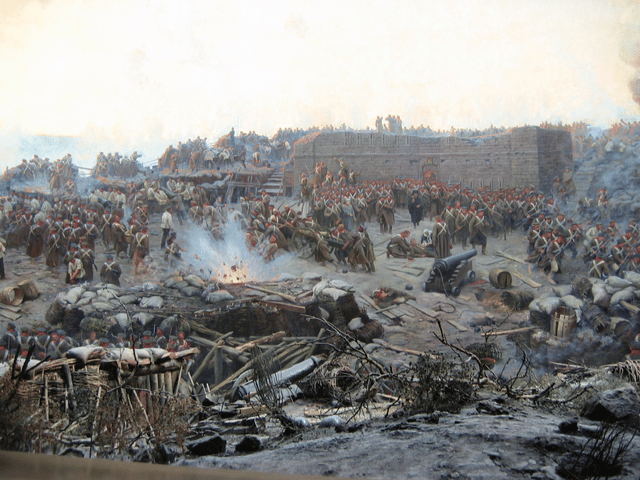
Crimean War

| Crimean War | |||||||
|---|---|---|---|---|---|---|---|
| Part of the Ottoman wars in Europe and the Russo-Turkish wars | |||||||
| |||||||
| Belligerents | |||||||
|
| ||||||
| Commanders and leaders | |||||||
| |||||||
| Strength | |||||||
| Total: 603,132 | Total: 889,000[3]
| ||||||
| Casualties and losses | |||||||
| 223,513 45,400[3] 10,100 killed in action 10,800 died of wounds 24,500 died of disease 135,485[3] 8,490 killed in action; 11,750 died of wounds; 75,375 died of disease 39,870 wounded 40,462[3] 2,755 killed in action 1,847 died of wounds 17,580 died of disease 18,280 wounded 2,166[3] 28 killed in action 2,138 died of disease | 530,125[3] 35,671 killed in action 37,454 died of wounds 377,000 died from non-combat causes 80,000 wounded[4][5] | ||||||
The Crimean War (French: Guerre de Crimée; Russian: Кры́мская война́, romanized: Krymskaya voyna or Russian: Восто́чная война́, romanized: Vostochnaya voyna, lit. 'Eastern War'; Turkish: Kırım Savaşı; Italian: Guerra di Crimea) was a military conflict fought from October 1853 to February 1856[6] in which the Russian Empire lost to an alliance of the Ottoman Empire, France, Britain and Sardinia. The immediate cause involved the rights of Christian minorities in the Holy Land, which was a part of the Ottoman Empire. The French promoted the rights of Roman Catholics, while Russia promoted those of the Eastern Orthodox Church. The longer-term causes involved the decline of the Ottoman Empire and the unwillingness of Britain and France to allow Russia to gain territory and power at Ottoman expense. It has widely been noted that the causes, in one case involving an argument over a key,[7] have never revealed a "greater confusion of purpose", yet they led to a war noted for its "notoriously incompetent international butchery".[8]
While the churches worked out their differences and came to an agreement, Nicholas I of Russia and the French Emperor Napoleon III refused to back down. Nicholas issued an ultimatum that the Orthodox subjects of the Ottoman Empire be placed under his protection. Britain attempted to mediate and arranged a compromise that Nicholas agreed to. When the Ottomans demanded changes, Nicholas refused and prepared for war. Having obtained promises of support from France and Britain, the Ottomans declared war on Russia in October 1853.
The war started in the Balkans in July 1853, when Russian troops occupied the Danubian Principalities[6] (now part of Romania), which were under Ottoman suzerainty, then began to cross the Danube. Led by Omar Pasha, the Ottomans fought a strong defensive campaign and stopped the advance at Silistra. A separate action on the fort town of Kars in eastern Anatolia led to a siege, and a Turkish attempt to reinforce the garrison was destroyed by a Russian fleet at Sinop. Fearing an Ottoman collapse, France and Britain rushed forces to Gallipoli. They then moved north to Varna in June 1854, arriving just in time for the Russians to abandon Silistra. Aside from a minor skirmish at Köstence (today Constanța), there was little for the allies to do. Karl Marx quipped, "there they are, the French doing nothing and the British helping them as fast as possible".[9]
Frustrated by the wasted effort, and with demands for action from their citizens, the allied force decided to attack Russia's main naval base in the Black Sea at Sevastopol on the Crimean peninsula. After extended preparations, the forces landed on the peninsula in September 1854 and marched their way to a point south of Sevastopol after the successful Battle of the Alma. The Russians counterattacked on 25 October in what became the Battle of Balaclava and were repulsed, but at the cost of seriously depleting the British Army forces. A second counterattack, at Inkerman, ended in stalemate. The front settled into a siege and led to brutal conditions for troops on both sides. Smaller military actions took place in the Baltic, the Caucasus, the White Sea, and the North Pacific.
Sevastopol fell after eleven months, and neutral countries began to join the Allied cause. Isolated and facing a bleak prospect of invasion from the west if the war continued, Russia sued for peace in March 1856. France and Britain welcomed this development, as the conflict was growing unpopular at home. The Treaty of Paris, signed on 30 March 1856, ended the war. It forbade Russia from basing warships in the Black Sea. The Ottoman vassal states of Wallachia and Moldavia became largely independent. Christians there were granted a degree of official equality, and the Orthodox Church regained control of the Christian churches in dispute.[10] []
The Crimean War was one of the first conflicts in which the military used modern technologies such as explosive naval shells, railways, and telegraphs.[11] [] The war was one of the first to be documented extensively in written reports and photographs. As the legend of the "Charge of the Light Brigade" demonstrates, the war quickly became an iconic symbol of logistical, medical and tactical failures and mismanagement. The reaction in Britain was a demand for professionalisation, most famously achieved by Florence Nightingale, who gained worldwide attention for pioneering modern nursing while treating the wounded.
The Crimean War proved to be the moment of truth for Nikolaevan Russia. The humiliation forced Russia's educated elites to identify the Empire's problems and to recognize the need for fundamental transformations aimed at modernizing and restoring Russia's position in the ranks of European powers. Historians have studied the role of the Crimean War as a catalyst for the reforms of Russia's social institutions: serfdom, justice, local self-government, education, and military service. More recently, scholars have also turned their attention to the impact of the Crimean War on the development of Russian nationalistic discourse.
| Crimean War | |||||||
|---|---|---|---|---|---|---|---|
| Part of the Ottoman wars in Europe and the Russo-Turkish wars | |||||||
| |||||||
| Belligerents | |||||||
|
| ||||||
| Commanders and leaders | |||||||
| |||||||
| Strength | |||||||
| Total: 603,132 | Total: 889,000[3]
| ||||||
| Casualties and losses | |||||||
| 223,513 45,400[3] 10,100 killed in action 10,800 died of wounds 24,500 died of disease 135,485[3] 8,490 killed in action; 11,750 died of wounds; 75,375 died of disease 39,870 wounded 40,462[3] 2,755 killed in action 1,847 died of wounds 17,580 died of disease 18,280 wounded 2,166[3] 28 killed in action 2,138 died of disease | 530,125[3] 35,671 killed in action 37,454 died of wounds 377,000 died from non-combat causes 80,000 wounded[4][5] | ||||||
The "Eastern Question"
As the Ottoman Empire steadily weakened during the 19th century, Russia stood poised to take advantage by expanding south. In the 1850s, the British and the French, who were allied with the Ottoman Empire, were determined not to allow this to happen.[12] A. J. P. Taylor argues that the war resulted not from aggression but from the interacting fears of the major players:
In some sense the Crimean war was predestined and had deep-seated causes. Neither Nicholas I nor Napoleon III nor the British government could retreat in the conflict for prestige once it was launched. Nicholas needed a subservient Turkey for the sake of Russian security; Napoleon needed success for the sake of his domestic position; the British government needed an independent Turkey for the security of the Eastern Mediterranean ... Mutual fear, not mutual aggression, caused the Crimean war.[13]
Weakening of the Ottoman Empire in 1820–1840s
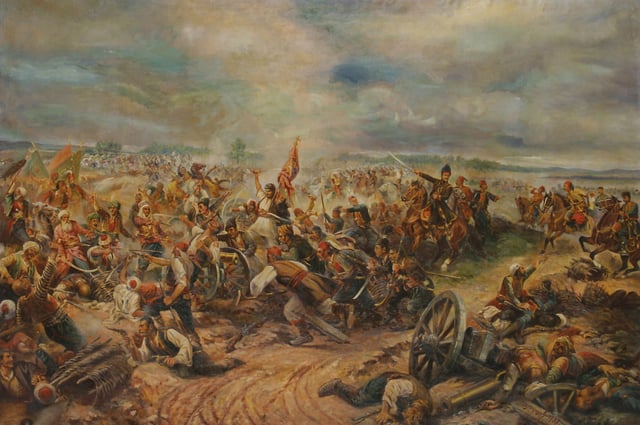
Serbian Uprising against the Ottoman Empire
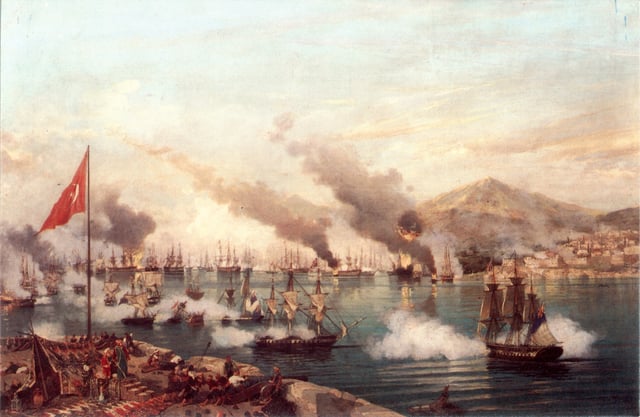
Naval Battle of Navarino, 1827
In the early 1800s, the Ottoman Empire suffered a number of setbacks which challenged the existence of the country. The Serbian Revolution in 1804 resulted in the self-liberation of the first Balkan Christian nation under the Ottoman Empire. The Greek War of Independence, which began in early 1821, provided further evidence of the internal and military weakness of the Ottoman Empire, and the commission of atrocities by Ottoman military forces (see Chios massacre) also undermined the Ottomans. The disbandment of the centuries-old Janissary corps by Sultan Mahmud II on 15 June 1826 (Auspicious Incident) helped the Ottoman Empire in the longer term, but in the short term it deprived the country of its existing standing army. In 1828, the allied Anglo-Franco-Russian fleet destroyed almost all the Ottoman naval forces during the Battle of Navarino. In 1830, Greece became an independent state after 10 years of war and the Russo-Turkish War (1828–29). According to the 1829 Treaty of Adrianople, Russian and Western European commercial ships were authorized to freely pass through the Black Sea straits, Serbia received autonomy, and the Danubian Principalities (Moldavia and Wallachia) became territories under Russian protection.
France took the opportunity to occupy Algeria in 1830. In 1831 Muhammad Ali of Egypt, who was the most powerful vassal of the Ottoman Empire, claimed independence. Ottoman forces were defeated in a number of battles, and the Egyptians were ready to capture Constantinople, which forced Sultan Mahmud II to seek Russian military aid. A Russian army of 10,000 landed on the Bosphorus shores in 1833 and helped to prevent the capture of Constantinople. As a result, the Treaty of Unkiar Skelessi was signed, benefiting Russia greatly. It provided for a military alliance between Russia and the Ottoman Empire, if one of them were to be attacked, and a secret additional clause allowed the Ottomans to opt out of sending troops but to close the Straits to foreign warships if Russia was under threat.
In 1838 the situation was similar to 1831. Muhammad Ali of Egypt was not happy about his lack of control and power in Syria, and he resumed military action. The Ottoman Army lost to the Egyptians at the Battle of Nezib on 24 June 1839. The Ottoman Empire was saved by Britain, Austria, Prussia and Russia, who signed a convention in London on 15 July 1840 granting Muhammad Ali and his descendants the right to inherit power in Egypt in exchange for removal of Egyptian armed forces from Syria and Lebanon. Moreover, Muhammad Ali had to admit a formal dependence to the Ottoman sultan. After Muhammad Ali refused to obey the requirements of the London convention, the allied Anglo-Austrian fleet blockaded the Nile Delta, bombarded Beirut and captured Acre. Muhammad Ali accepted the conditions of the London convention in 1840.
On 13 July 1841, after the expiry of the Treaty of Unkiar Skelessi, the London Straits Convention was signed under pressure from European countries. The new treaty deprived Russia of its right to block warships from passing into the Black Sea in case of war. Thus the way to the Black Sea was open for British and French warships in case of a possible Russo-Ottoman conflict.
It must be said that this fact confirms the statements of Russian historians about the absence of aggressive plans of Russia. Russian historian writes: "The signing of the documents was the result of deliberate decisions: instead of bilateral (none of the great powers recognized this Treaty of Unkiar Skelessi), the new Treaty of London was obligatory for all, it closed the Bosphorus and Dardanelles." [14]
Assistance from Western European powers had twice saved the Ottoman Empire from destruction, but the Ottomans had now lost their independence in external policy. Britain and France desired more than any other states to preserve the integrity of the Ottoman Empire because they did not want to see Russia gaining access to the Mediterranean Sea. Austria had fears for the same reasons. The travel writer Charles Boileau Elliott wrote about the conflicts and relationships between the Ottoman government, Russia, and the Tatars in his diary Travels In The Three Great Empires of Austria, Russia, and Turkey (1838). Even back during this time there was significant dispute about which governments should control the destiny of the Crimean Peninsula.
Russian expansionism
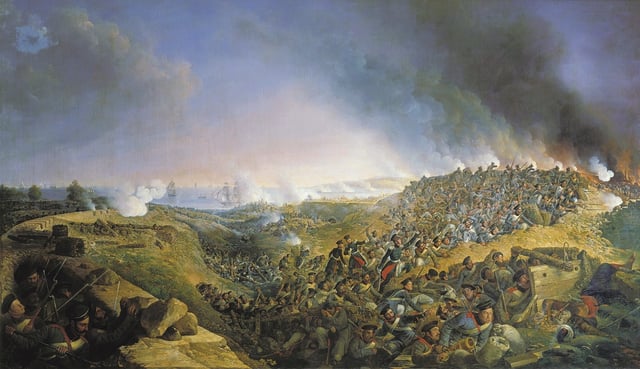
Russian siege of Varna in Ottoman-ruled Bulgaria, July–September 1828
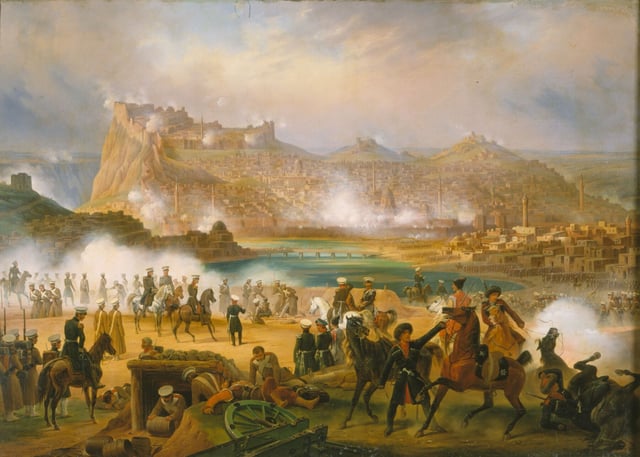
Russian siege of Kars, Russo-Turkish War of 1828–29
Russia, as a member of the Holy Alliance, had operated as the "police of Europe", maintaining the balance of power that had been established in the Treaty of Vienna in 1815. Russia had assisted Austria's efforts in suppressing the Hungarian Revolution of 1848, and expected gratitude; it wanted a free hand in settling its problems with the Ottoman Empire, the "sick man of Europe". Britain could not tolerate Russian dominance of Ottoman affairs, as that would challenge its domination of the eastern Mediterranean.[15]
Starting with Peter the Great, after centuries of Ottoman northward expansion and Crimean-Nogai raids, Russia had been expanding southwards across the sparsely populated "Wild Fields" toward the warm water ports of the Black Sea, which did not freeze over like the handful of ports it controlled in the north. The goal was to promote year-round trade and a year-round navy.[10] [] Pursuit of this goal brought the emerging Russian state into conflict with the Ukrainian Cossacks and then with the Tatars of the Crimean Khanate[16] and Circassians.[17] When Russia conquered these groups and gained possession of their territories, the Ottoman Empire lost its buffer zone against Russian expansion, and Russia and the Ottoman Empire came into direct conflict. The conflict with the Ottoman Empire also presented a religious issue of importance, as Russia saw itself as the protector of Orthodox Christians, many of whom lived under Ottoman control and were treated as second-class citizens.[10] []
Britain's immediate fear was Russian expansion at the expense of the Ottoman Empire, which Britain desired to preserve. The British were also concerned that Russia might make advances toward British India, or move toward Scandinavia or Western Europe. The Royal Navy also wanted to forestall the threat of a powerful Russian navy.[18] Taylor says that from the British perspective:
The Crimean war was fought for the sake of Europe rather than for the Eastern question; it was fought against Russia, not in favour of Turkey ... The British fought Russia out of resentment and supposed that her defeat would strengthen the European Balance of Power.[19]
British historian Orlando Figes wrote that Mikhail Pogodin, professor of history at Moscow University, "had been asked by Nicholas to give his thoughts on Russia’s policy towards the Slavs in the war against Turkey. His answer was a detailed survey of Russia’s relations with the European powers which was filled with grievances against the West. The memorandum clearly struck a chord with Nicholas, who shared Pogodin’s sense that Russia’s role as the protector of the Orthodox had not been recognized or understood and that Russia was unfairly treated by the West. Nicholas especially approved of the following passage":[21]
France takes Algeria from Turkey, and almost every year England annexes another Indian principality: none of this disturbs the balance of power; but when Russia occupies Moldavia and Wallachia, albeit only temporarily, that disturbs the balance of power. France occupies Rome and stays there several years during peacetime: that is nothing; but Russia only thinks of occupying Constantinople, and the peace of Europe is threatened. The English declare war on the Chinese, who have, it seems, offended them: no one has the right to intervene; but Russia is obliged to ask Europe for permission if it quarrels with its neighbor. England threatens Greece to support the false claims of a miserable Jew and burns its fleet: that is a lawful action; but Russia demands a treaty to protect millions of Christians, and that is deemed to strengthen its position in the East at the expense of the balance of power. We can expect nothing from the West but blind hatred and malice... (comment in the margin by Nicholas I: ‘This is the whole point’).— Mikhail Pogodin's memorandum to Nicholas I, 1853[22]
It is often said that Russia was militarily weak, technologically backward and administratively incompetent. Despite its grand ambitions toward the south, it had not built its railway network in that direction, and communications were poor. The bureaucracy was riddled with graft, corruption and inefficiency and was unprepared for war. Its navy was weak and technologically backward; its army, although very large, suffered from colonels who pocketed their men's pay, from poor morale, and from a technological deficit relative to Britain and France. By the war's end, the profound weaknesses of the Russian armed forces were readily apparent, and the Russian leadership was determined to reform it.[23][24]
Immediate causes of the war
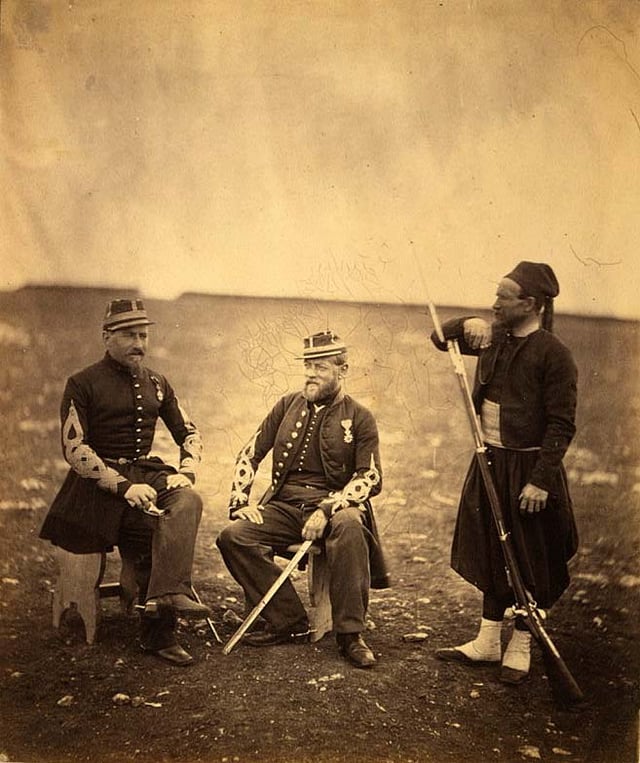
Two French Zouaves officers and one private
The French emperor Napoleon III's ambition to restore the grandeur of France[25] initiated the immediate chain of events leading to France and Britain declaring war on Russia on 27 and 28 March 1854, respectively. He pursued Roman Catholic support by asserting France's "sovereign authority" over the Christian population of Palestine,[11] [] to the detriment of Russia[10] [] (the sponsor of Eastern Orthodoxy). To achieve this, in May 1851, Napoleon appointed the Marquis Charles de La Valette (a zealous leading member of the Catholic "clerical party") as his ambassador to the Sublime Porte of the Ottoman Empire.[10] []
Russia disputed this attempted change in authority. Referencing two previous treaties (one from 1757, and the Treaty of Küçük Kaynarca from 1774), the Ottomans reversed their earlier decision, renouncing the French treaty, and declaring that Russia was the protector of the Orthodox Christians in the Ottoman Empire.
Napoleon III responded with a show of force, sending the ship of the line Charlemagne to the Black Sea, thereby violating the London Straits Convention.[10] [] [11] [] This gunboat diplomacy show of force, together with money, induced the Ottoman Sultan Abdülmecid I to accept a new treaty, confirming France and the Roman Catholic Church's supreme authority over Catholic holy places, including the Church of the Nativity, previously held by the Greek Orthodox Church.[11] []
Tsar Nicholas I then deployed his 4th and 5th army corps along the River Danube in Wallachia, as a direct threat to the Ottoman lands south of the river. He had Count Karl Nesselrode, his foreign minister, undertake talks with the Ottomans. Nesselrode confided to Sir George Hamilton Seymour, the British ambassador in Saint Petersburg:
[The dispute over the holy places] had assumed a new character—that the acts of injustice towards the Greek church which it had been desired to prevent had been perpetrated and consequently that now the object must be to find a remedy for these wrongs. The success of French negotiations at Constantinople was to be ascribed solely to intrigue and violence—violence which had been supposed to be the ultima ratio of kings, being, it had been seen, the means which the present ruler of France was in the habit of employing in the first instance.[11] []
As conflict emerged over the issue of the holy places, Nicholas I and Nesselrode began a diplomatic offensive, which they hoped would prevent either British or French interference in any conflict between Russia and the Ottomans, as well as to prevent an anti-Russian alliance of the two.
Nicholas began courting Britain by means of conversations with the British ambassador, George Hamilton Seymour, in January and February 1853.[10] [] Nicholas insisted that he no longer wished to expand Imperial Russia[10] [] but that he had an obligation to the Christian communities in the Ottoman Empire.[10] []
The Tsar next dispatched a highly abrasive diplomat, Prince Menshikov, on a special mission to the Ottoman Sublime Porte in February 1853. By previous treaties, the sultan was committed "to protect the (Eastern Orthodox) Christian religion and its churches". Menshikov demanded a Russian protectorate over all 12 million Orthodox Christians in the Empire, with control of the Orthodox Church's hierarchy. A compromise was reached regarding Orthodox access to the Holy Land, but the Sultan, strongly supported by the British ambassador, rejected the more sweeping demands.[26]
First hostilities
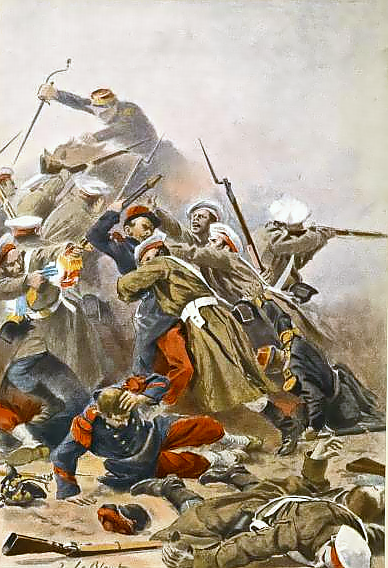
Russo-French skirmish during the Crimean War
In February 1853, the British government of Lord Aberdeen, the prime minister, re-appointed Stratford Canning as British ambassador to the Ottoman Empire.[10] [] Having resigned the ambassadorship in January, he had been replaced by Colonel Rose as chargé d'affaires. Lord Stratford then turned around and sailed back to Constantinople, arriving there on 5 April 1853. There he convinced the Sultan to reject the Russian treaty proposal, as compromising the independence of the Turks. The Leader of the Opposition in the British House of Commons, Benjamin Disraeli, blamed Aberdeen and Stratford's actions for making war inevitable, thus starting the process which forced the Aberdeen government to resign in January 1855, over the war.
Shortly after he learned of the failure of Menshikov's diplomacy toward the end of June 1853, the Tsar sent armies under the commands of Field Marshal Ivan Paskevich and General Mikhail Gorchakov across the River Pruth into the Ottoman-controlled Danubian Principalities of Moldavia and Wallachia. Fewer than half of the 80,000 Russian soldiers who crossed the Pruth in 1853 survived. By far, most of the deaths would result from sickness rather than action,[10] [] for the Russian army still suffered from medical services that ranged from bad to none.
Russia had obtained recognition from the Ottoman Empire of the Tsar's role as special guardian of the Orthodox Christians in Moldavia and Wallachia. Now Russia used the Sultan's failure to resolve the issue of the protection of the Christian sites in the Holy Land as a pretext for Russian occupation of these Danubian provinces. Nicholas believed that the European powers, especially Austria, would not object strongly to the annexation of a few neighbouring Ottoman provinces, especially considering that Russia had assisted Austria's efforts in suppressing the 1848 Hungarian Revolution in 1849.
In July 1853, the Tsar sent his troops into the Danubian Principalities. The United Kingdom, hoping to maintain the Ottoman Empire as a bulwark against the expansion of Russian power in Asia, sent a fleet to the Dardanelles, where it joined another fleet sent by France.[27]
Sultan Abdulmecid I declared war on Russia and proceeded to the attack, his armies moving on the Russian Army near the Danube later that month.[10] [] Russia and the Ottoman Empire massed forces on two main fronts, the Caucasus and the Danube. Ottoman leader Omar Pasha managed to achieve some victories on the Danubian front.[28] In the Caucasus, the Ottomans were able to stand ground with the help of Chechen Muslims led by Imam Shamil.[29]
Battle of Sinop
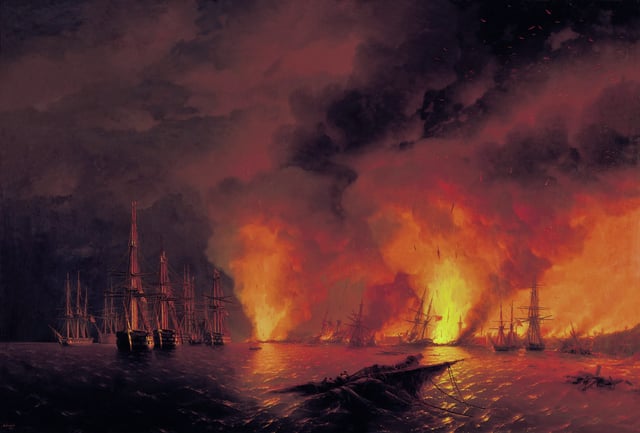
The Russian destruction of the Turkish fleet at the Battle of Sinop on 30 November 1853 sparked the war (painting by Ivan Aivazovsky).
The European powers continued to pursue diplomatic avenues. The representatives of the four neutral Great Powers (the United Kingdom, France, Austria and Prussia) met in Vienna, where they drafted a note that they hoped would be acceptable to both the Russians and the Ottomans. The peace terms arrived at by the four powers at the Vienna Conference (1853) were delivered to the Russians by the Austrian Foreign Minister Count Karl von Buol on 5 December 1853. The note met with the approval of Nicholas I, but Abdülmecid I rejected the proposal, feeling that the document's poor phrasing left it open to many different interpretations. The United Kingdom, France and Austria united in proposing amendments to mollify the Sultan, but the court of St. Petersburg ignored their suggestions.[10] [] The United Kingdom and France then set aside the idea of continuing negotiations, but Austria and Prussia did not believe that the rejection of the proposed amendments justified the abandonment of the diplomatic process.
On 23 November, the Russian convoy of 3 battle ships discovered the Ottoman fleet harbored in Sinop harbor. Along with the additional 5 battle ships, in the Battle of Sinop on 30 November 1853, they destroyed a patrol squadron of 11 Ottoman battle ships while they were anchored in port under defense of the onshore artillery garrison. The United Kingdom and French press shaped the public opinion to demand the war. Both used Sinop as the casus belli ("act of war") for declaring war against Russia. On 28 March 1854, after Russia ignored an Anglo-French ultimatum to withdraw from the Danubian Principalities, the UK and France declared war.[30][31]
Dardanelles
Britain was concerned about Russian activity and Sir John Burgoyne, senior advisor to Lord Aberdeen, urged that the Dardanelles should be occupied and works of sufficient strength built to block any Russian move to capture Constantinople and gain access to the Mediterranean Sea. The Corps of Royal Engineers sent men to the Dardanelles, while Burgoyne went to Paris, meeting the British Ambassador and the French Emperor. Lord Cowley wrote on 8 February to Burgoyne, "Your visit to Paris has produced a visible change in the Emperor's views, and he is making every preparation for a land expedition in case the last attempt at negotiation should break down."[32] []
Burgoyne and his team of engineers inspected and surveyed the Dardanelles area in February, and were fired on by Russian riflemen when they went to Varna. A team of sappers arrived in March, and major building works commenced on a seven-mile line of defence designed to block the Gallipoli peninsula. French sappers were working on one half of the line, which was finished in May.[32] []
Peace attempts
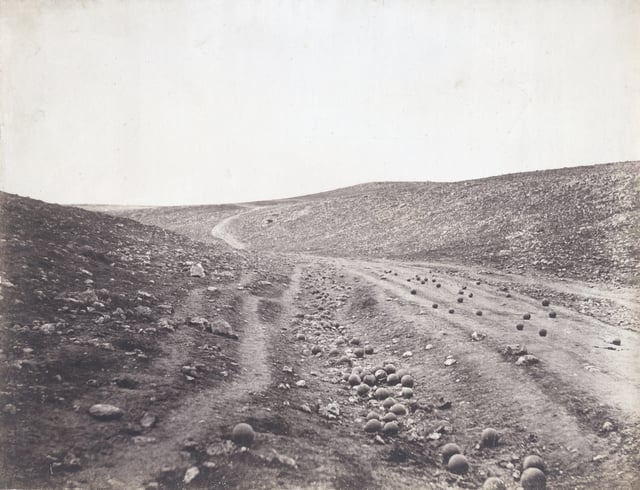
Valley of the Shadow of Death, by Roger Fenton, one of the most famous pictures of the Crimean War[33]
Nicholas felt that, because of Russian assistance in suppressing the Hungarian revolution of 1848, Austria would side with him, or at the very least remain neutral. Austria, however, felt threatened by the Russian troops in the Balkans. On 27 February 1854, the United Kingdom and France demanded the withdrawal of Russian forces from the principalities. Austria supported them, and, though it did not declare war on Russia, it refused to guarantee its neutrality. Russia's rejection of the ultimatum proved to be the justification used by Britain and France to enter the war.
Russia soon withdrew its troops from the Danubian principalities, which were then occupied by Austria for the duration of the war.[34] This removed the original grounds for war, but the UK and France continued with hostilities. Determined to address the Eastern Question by putting an end to the Russian threat to the Ottoman Empire, the allies in August 1854 proposed the "Four Points" for ending the conflict, in addition to the Russian withdrawal:
Russia was to give up its protectorate over the Danubian Principalities;
The Danube was to be opened up to foreign commerce;
The Straits Convention of 1841, which allowed only Ottoman and Russian warships in the Black Sea, was to be revised;
Russia was to abandon any claim granting it the right to interfere in Ottoman affairs on behalf of Orthodox Christians.
These points (particularly the third) would require clarification through negotiation, but Russia refused to negotiate. The allies including Austria therefore agreed that Britain and France should take further military action to prevent further Russian aggression against the Ottoman Empire. Britain and France agreed on the invasion of the Crimean peninsula as the first step.[35]
Battles
Danube campaign
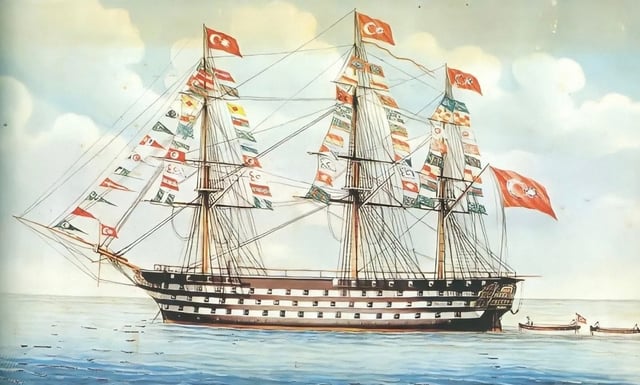
Mahmudiye (1829) participated in numerous important naval battles, including the Siege of Sevastopol
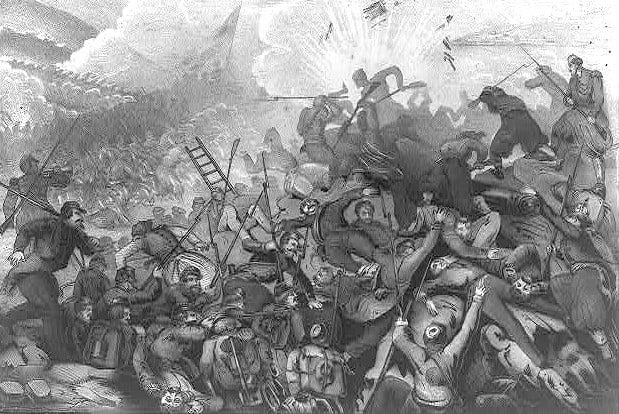
French zouaves and Russian soldiers engaged in hand-to-hand combat at Malakhov Kurgan
The Danube campaign opened when the Russians occupied the Danubian Principalities of Moldavia and Wallachia in May 1853, bringing their forces to the north bank of the River Danube. In response, the Ottoman Empire also moved its forces up to the river, establishing strongholds at Vidin in the west and Silistra[10] [] in the east, near the mouth of the Danube. The Ottoman move up the River Danube was also of concern to the Austrians, who moved forces into Transylvania in response. However, the Austrians had begun to fear the Russians more than the Turks. Indeed, like the British, the Austrians were now coming to see that an intact Ottoman Empire was necessary as a bulwark against the Russians. Accordingly, Austria resisted Russian diplomatic attempts to join the war on the Russian side and remained neutral in the Crimean War.[36]
Following the Ottoman ultimatum in September 1853, forces under the Ottoman general Omar Pasha crossed the Danube at Vidin and captured Calafat in October 1853. Simultaneously, in the east, the Ottomans crossed the Danube at Silistra and attacked the Russians at Oltenița. The resulting Battle of Oltenița was the first engagement following the declaration of war. The Russians counterattacked, but were beaten back.[37] On 31 December 1853, the Ottoman forces at Calafat moved against the Russian force at Chetatea or Cetate, a small village nine miles north of Calafat, and engaged them on 6 January 1854. The battle began when the Russians made a move to recapture Calafat. Most of the heavy fighting took place in and around Chetatea until the Russians were driven out of the village. Despite the setback at Chetatea, on 28 January 1854, Russian forces laid siege to Calafat. The siege would continue until May 1854 when the Russians lifted the siege. The Ottomans would also later beat the Russians in battle at Caracal.[10] []
In early 1854 the Russians again advanced, crossing the River Danube into the Turkish province of Dobruja. By April 1854, the Russians had reached the lines of Trajan's Wall where they were finally halted. In the centre, the Russian forces crossed the Danube and laid siege to Silistra from 14 April with 60,000 troops, the defenders with 15,000 had supplies for three months.[32] [] The siege was lifted on 23 June 1854.[38] The English and French forces at this time were unable to take the field for lack of equipment.[32] []
In the west, the Russians were dissuaded from attacking Vidin by the presence of the Austrian forces, which had swelled to 280,000 men. On 28 May 1854 a protocol of the Vienna Conference was signed by Austria and Russia. One of the aims of the Russian advance had been to encourage the Orthodox Christian Serbs and Bulgarians living under Ottoman rule to rebel. When the Russian troops crossed the River Pruth into Moldavia, the Orthodox Christians showed no interest in rising up against the Turks.[10] [] Adding to the worries of Nicholas I was the concern that Austria would enter the war against the Russians and attack his armies on the western flank. Indeed, after attempting to mediate a peaceful settlement between Russia and Turkey, the Austrians entered the war on the side of Turkey with an attack against the Russians in the Principalities which threatened to cut off the Russian supply lines. Accordingly, the Russians were forced to raise the siege of Silistra on 23 June 1854, and begin abandoning the Principalities.[10] [] The lifting of the siege reduced the threat of a Russian advance into Bulgaria.
In June 1854, the Allied expeditionary force landed at Varna, a city on the Black Sea's western coast. They made little advance from their base there.[10] [] In July 1854, the Turks under Omar Pasha crossed the Danube into Wallachia and on 7 July 1854 engaged the Russians in the city of Giurgiu and conquered it. The capture of Giurgiu by the Turks immediately threatened Bucharest in Wallachia with capture by the same Turkish army. On 26 July 1854, Tsar Nicholas I, responding to an Austrian ultimatum, ordered the withdrawal of Russian troops from the Principalities. Also, in late July 1854, following up on the Russian retreat, the French staged an expedition against the Russian forces still in Dobruja, but this was a failure.[10] []
By then, the Russian withdrawal was complete, except for the fortress towns of northern Dobruja, while their place in the Principalities was taken by the Austrians, as a neutral peacekeeping force.[10] [] There was little further action on this front after late 1854, and in September the allied force boarded ships at Varna to invade the Crimean Peninsula.[10] []
Black Sea theatre
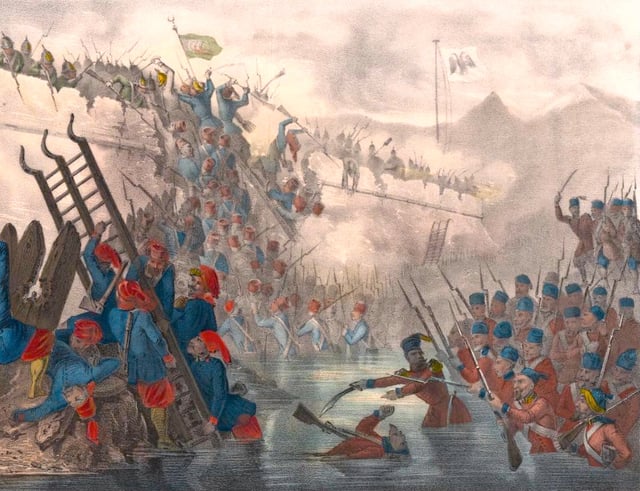
Turkish troops storming Fort Shefketil
The naval operations of the Crimean War commenced with the dispatch, in mid-1853, of the French and British fleets to the Black Sea region, to support the Ottomans and to dissuade the Russians from encroachment. By June 1853, both fleets were stationed at Besikas Bay, outside the Dardanelles. With the Russian occupation of the Danube Principalities in October, they moved to the Bosphorus and in November entered the Black Sea.
During this period, the Russian Black Sea Fleet was operating against Ottoman coastal traffic between Constantinople and the Caucasus ports, while the Ottoman fleet sought to protect this supply line. The clash came on 30 November 1853 when a Russian fleet attacked an Ottoman force in the harbour at Sinop, and destroyed it at the Battle of Sinop. The battle outraged opinion in UK, which called for war.[39] There was little additional naval action until March 1854 when on the declaration of war the British frigate HMS Furious was fired on outside Odessa Harbour. In response an Anglo-French fleet bombarded the port, causing much damage to the town. To show support for Turkey after the battle of Sinop, on 22 December 1853, the Anglo-French squadron entered the Black Sea and the steamship HMS Retribution approached the Port of Sevastopol, the commander of which received an ultimatum not to allow any ships in the Black Sea.
In June, the fleets transported the Allied expeditionary forces to Varna, in support of the Ottoman operations on the Danube; in September they again transported the armies, this time to the Crimea. The Russian fleet during this time declined to engage the allies, preferring to maintain a "fleet in being"; this strategy failed when Sevastopol, the main port and where most of the Black Sea fleet was based, came under siege. The Russians were reduced to scuttling their warships as blockships, after stripping them of their guns and men to reinforce batteries on shore. During the siege, the Russians lost four 110- or 120-gun, three-decker ships of the line, twelve 84-gun two-deckers and four 60-gun frigates in the Black Sea, plus a large number of smaller vessels. During the rest of the campaign the allied fleets remained in control of the Black Sea, ensuring the various fronts were kept supplied.
In May 1855, the allies successfully invaded Kerch and operated against Taganrog in the Sea of Azov. In September they moved against Russian installations in the Dnieper estuary, attacking Kinburn in the first use of ironclad ships in naval warfare.
Crimean campaign
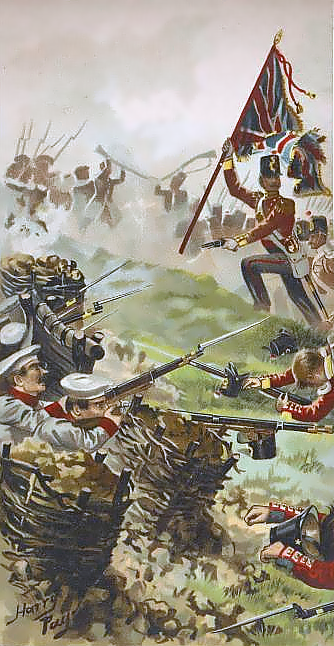
Russo-British skirmish during the Crimean War
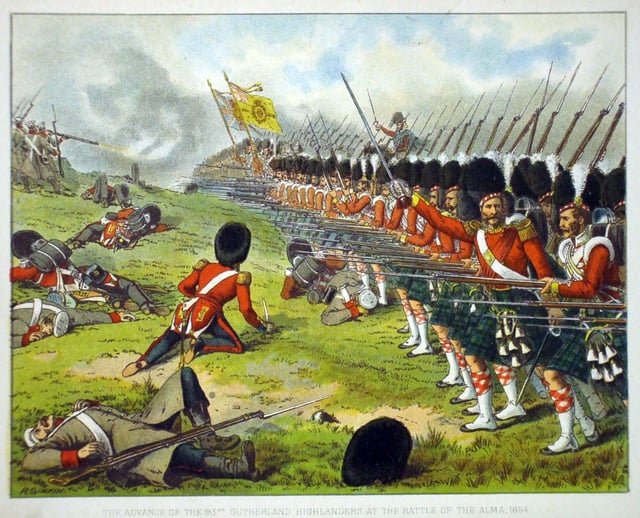
93rd Sutherland Highlanders at the Battle of Alma
The Russians evacuated Wallachia and Moldavia in late July 1854. With the evacuation of the Danubian Principalities, the immediate cause of war was withdrawn and the war might have ended at this time.[10] [] However, war fever among the public in both the UK and France had been whipped up by the press in both countries to the degree that politicians found it untenable to propose ending the war at this point. The coalition government of George Hamilton-Gordon, 4th Earl of Aberdeen fell on 30 January 1855 on a no-confidence vote as Parliament voted to appoint a committee to investigate mismanagement of the war.[10] []
French and British officers and engineers were sent on 20 July on HMS Fury, a wooden Bulldog-class paddle sloop, to survey the harbour of Sevastopol and the coast near it, managing to get close to the harbour mouth to inspect the formidable batteries. Returning, they reported that they believed there were 15,000–20,000 troops encamped.[32] [] Ships were prepared to transport horses and siege equipment was both manufactured and imported.[32] []
The Crimean campaign opened in September 1854. Three hundred and sixty ships sailed in seven columns, each steamer towing two sailing ships.[32] [] Anchoring on 13 September in the bay of Eupatoria, the town surrendered and 500 marines landed to occupy it. This town and bay would provide a fall back position in case of disaster.[10] [] The ships then sailed east to make the landing of the allied expeditionary force on the sandy beaches of Calamita Bay on the south west coast of the Crimean Peninsula. The landing surprised the Russians, as they had expected a landing at Katcha; the last-minute change proving that Russia had known the original campaign plan. There was no sign of the enemy and the invading troops all landed on 14 September 1854. It took another four days to land all the stores, equipment, horses and artillery.
The landing took place north of Sevastopol, so the Russians had arrayed their army in expectation of a direct attack. The allies advanced and on the morning of 20 September came up to the River Alma and engaged the Russian army. The position was strong, but after three hours,[32] [] the allied frontal attack had driven the Russians out of their dug-in positions with losses of 6,000 men. The Battle of the Alma resulted in 3,300 Allied losses. Failing to pursue the retreating forces was one of many strategic errors made during the war, and the Russians themselves noted that had the Allies pressed south that day they would have easily captured Sevastopol.
Believing the northern approaches to the city too well defended, especially due to the presence of a large star fort and because Sevastopol was on the south side of the inlet from the sea that made the harbour, Sir John Burgoyne, the engineer advisor, recommended that the allies attack Sevastopol from the south. The joint commanders, Raglan and St Arnaud, agreed.[32] [] On 25 September the whole army began to march southeast and encircled the city from the south, after establishing port facilities at Balaclava for the British and at Kamiesch (Russian: Камышовая бухта, romanized: Kamyshovaya bukhta) for the French. The Russians retreated into the city.[40][41]
The Allied army moved without problems to the south and the heavy artillery was brought ashore with batteries and connecting trenches built so that by 10 October some batteries were ready and by 17 October—when the bombardment commenced—126 guns were firing, 53 of them French.[32] [] The fleet at the same time engaged the shore batteries. The British bombardment worked better than that of the French, who had smaller-calibre guns. The fleet suffered high casualties during the day. The British wanted to attack that afternoon, but the French wanted to defer the attack. A postponement was agreed, but on the next day the French were still not ready. By 19 October the Russians had transferred some heavy guns to the southern defences and outgunned the allies.[32] []
Reinforcements for the Russians gave them the courage to send out probing attacks. The Allied lines, beginning to suffer from cholera as early as September, were stretched. The French, on the west had less to do than the British on the east with their siege lines and the large nine-mile open wing back to their supply base on the south coast.
Battle of Balaclava
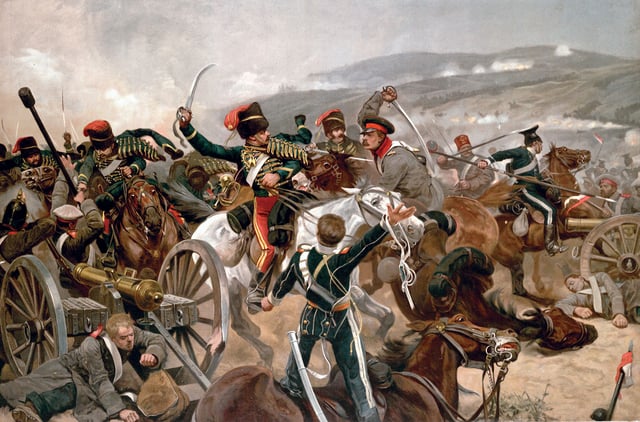
British cavalry charging against Russian forces at Balaclava
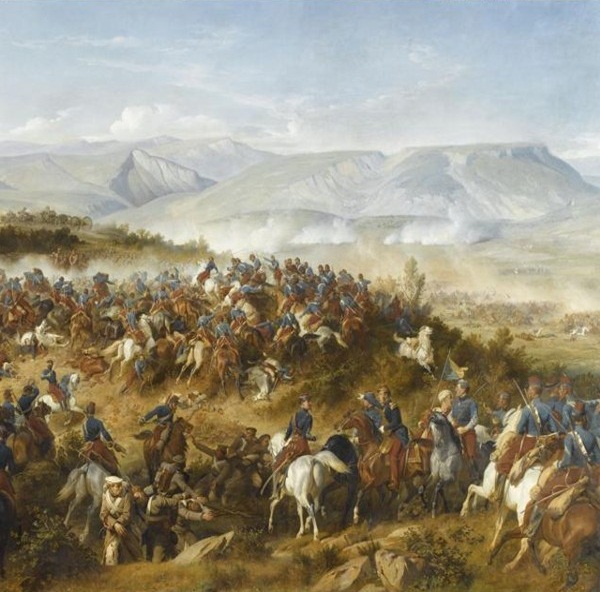
The Chasseurs d'Afrique, led by General d'Allonville, clearing Russian artillery from the Fedyukhin Heights during the Battle of Balaclava
A large Russian assault on the allied supply base to the southeast at Balaclava was rebuffed on 25 October 1854. [] The Battle of Balaclava is remembered in the UK for the actions of two British units. At the start of the battle, a large body of Russian cavalry charged the 93rd Highlanders, who were posted north of the village of Kadikoi. Commanding them was Sir Colin Campbell. Rather than "form square", the traditional method of repelling cavalry, Campbell took the risky decision to have his Highlanders form a single line, two men deep. Campbell had seen the effectiveness of the new Minie rifles, with which his troops were armed, at the Battle of Alma a month before, and he was confident his men could beat back the Russians. His tactics succeeded.[42] From up on the ridge to the west, Times correspondent William Howard Russell saw the Highlanders as a "thin red streak topped with steel", a phrase which soon became the "Thin Red Line".[43]
Soon after, a Russian cavalry movement was countered by the Heavy Brigade, who charged and fought hand-to-hand until the Russians retreated. This caused a more widespread Russian retreat, including a number of their artillery units. When the local commanders failed to take advantage of the retreat, Lord Raglan sent out orders to move up and prevent the withdrawal of naval guns from the recently captured redoubts on the heights. Raglan could see these guns due to his position on the hill; when in the valley, this view was obstructed, leaving the wrong guns in sight. The local commanders ignored the demands, leading to the British aide-de-camp (Captain Nolan) personally delivering the quickly written and confusing order to attack the artillery. When Lord Lucan questioned which guns the order referred to, the aide-de-camp pointed to the first Russian battery he could see and allegedly said "There is your enemy, there are your guns"—due to his obstructed view, these were the wrong ones. Lucan then passed the order to the Earl of Cardigan, resulting in the charge of the Light Brigade.
In this charge, Cardigan formed up his unit and charged the length of the Valley of the Balaclava, under fire from Russian batteries in the hills. The charge of the Light Brigade caused 278 casualties of the 700-man unit. The Light Brigade was memorialised in the famous poem by Alfred, Lord Tennyson, "The Charge of the Light Brigade". Although traditionally the charge of the Light Brigade was looked upon as a glorious but wasted sacrifice of good men and horses, recent historians say that the charge of the Light Brigade did succeed in at least some of its objectives.[44] The aim of any cavalry charge is to scatter the enemy lines and frighten the enemy off the battlefield. The charge of the Light Brigade so unnerved the Russian cavalry, which had been routed by the Heavy Brigade, that the Russians were set to full-scale flight.[10] [] [45]
The shortage of men led to the failure of the British and French to follow up on the Battle of Balaclava, which led directly to a much bloodier battle—the Battle of Inkerman. On 5 November 1854, the Russians attempted to raise the siege at Sevastopol with an attack against the allies, which resulted in another allied victory.[46]
The winter of 1854–55

Historical map showing the territory between Balaclava and Sevastopol at the time of the Siege of Sevastopol
Winter weather and a deteriorating supply of troops and materiel on both sides led to a halt in ground operations. Sevastopol remained invested by the allies, while the allied armies were hemmed in by the Russian Army in the interior. On 14 November the "Balaklava Storm" sank thirty allied transport ships,[47] including HMS Prince, which was carrying a cargo of winter clothing.[32] [] The storm and heavy traffic caused the road from the coast to the troops to disintegrate into a quagmire, requiring engineers to devote most of their time to its repair including quarrying stone. A tramway was ordered. It arrived in January with a civilian engineering crew, but it was March before it was sufficiently advanced to be of any appreciable value.[32] [] An electrical telegraph was also ordered, but the frozen ground delayed its installation until March, when communications from the base port of Balaklava to the British HQ was established. The pipe-and-cable-laying plough failed because of the hard frozen soil, but nevertheless 21 miles of cable were laid.[32] []
The troops suffered greatly from cold and sickness, and the shortage of fuel led them to start dismantling their defensive Gabions and Fascines.[32] [] In February 1855, the Russians attacked the allied base at Eupatoria, where an Ottoman army had built up and was threatening Russian supply routes. The Russians were defeated in the battle,[10] [] leading to a change in their command.
Siege of Sevastopol
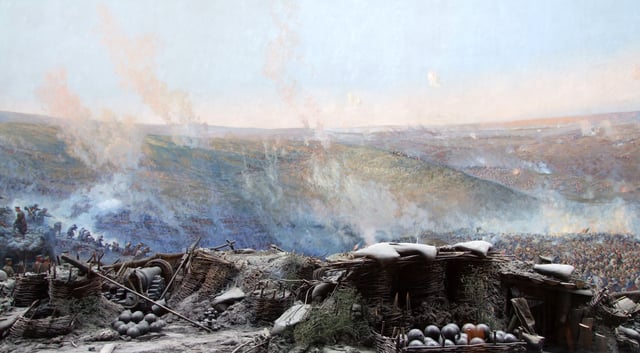
Siege of Sevastopol
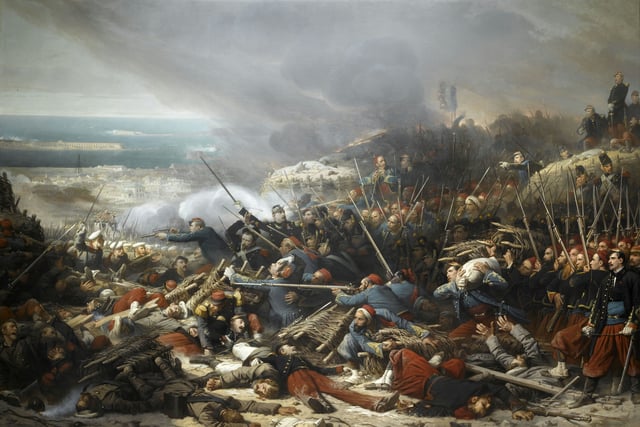
Battle of Malakoff

Battle of the Chernaya, the forces at the beginning of the battle and the Russian advance
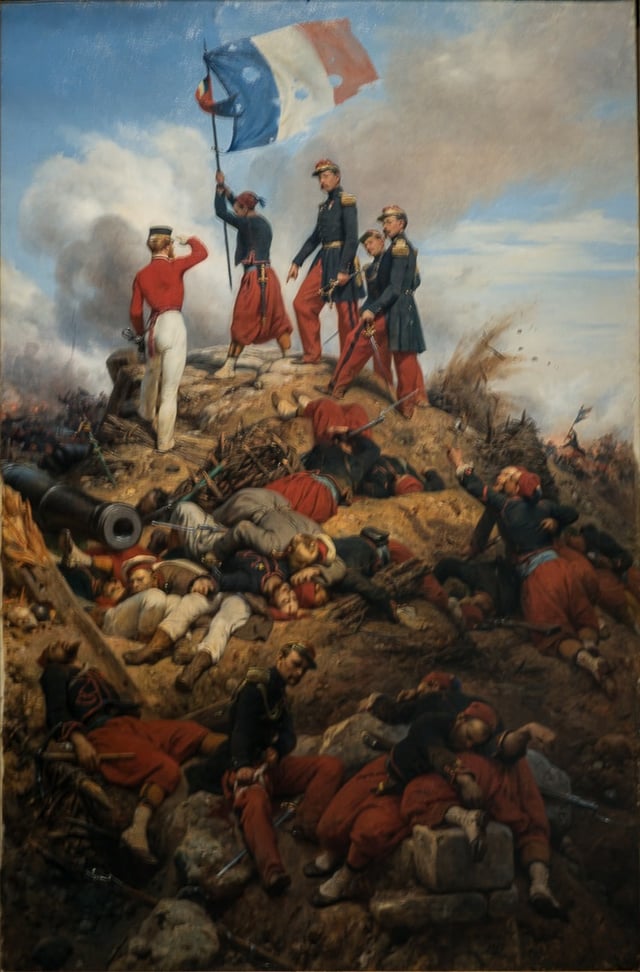
The French captured Sevastopol after a nearly year-long siege.
The Allies had had time to consider the problem, the French being brought around to agree that the key to the defence was the Malakoff.[32] [] Emphasis of the siege at Sevastopol shifted to the British left, against the fortifications on Malakoff hill.[10] [] In March, there was fighting by the French over a new fort being built by the Russians at Mamelon, located on a hill in front of the Malakoff. Several weeks of fighting resulted in little change in the front line, and the Mamelon remained in Russian hands.
On 24 May 1855, sixty ships containing 7,000 French, 5,000 Turkish and 3,000 British troops set off for a raid on the city of Kerch east of Sevastopol in an attempt to open another front on the Crimean peninsula and to cut off Russian supplies.[10] [] When the allies landed the force at Kerch, the plan was to outflank the Russian Army. The landings were successful, but the force made little progress thereafter.
Many more artillery pieces had arrived and had been dug into batteries. The first General assault of Sevastopol took place on June 18, 1855. There is a legend that the assault was scheduled for this date in favour of Napoleon III in the 40th anniversary of the battle of Waterloo. This legend is not confirmed by historians.[49] But undoubtedly the appearance of such a legend is symptomatic, if we remember that the war in France was understood as a certain revanche for the defeat of 1812.
In June, a third bombardment was followed after two days by a successful attack on the Mamelon, but a follow-up assault on the Malakoff failed with heavy losses. During this time the garrison commander, Admiral Nakhimov fell on 30 June 1855,[10] [] and Raglan died on 28 June.[32] [] Losses in these battles were so great that by agreement of military opponents short-term truces for removal of corpses were signed (these truces were described in the work Of Leo Tolstoy "Sevastopol sketches"). The assault was beaten back with heavy casualties and it was an undoubted victory of Russia. It is worth mentioning that the Russian Siege of Sevastopol (panorama) depicts the moment of the assault of Sevastopol on June 18, 1855.
For months each side had been building forward rifle pits and defensive positions, which resulted in many skirmishes. Artillery fire aimed to gain superiority over the enemy guns.[32] [] The final assault was made on 5 September, when another French bombardment (the sixth) was followed by an assault by the French Army on 8 September, resulting in the French capture of the Malakoff fort. The Russians failed to retake it and their defences collapsed. Meanwhile, the British assaulted the Great Redan, a Russian defensive battlement just south of the city of Sevastopol—a position that had been attacked repeatedly for months. Whether the British captured the Redan remains in dispute: Russian historians recognize only the loss of the Malakhov Kurgan (a key point of defence), claiming that all other positions were retained.[50] What is agreed is that the Russians abandoned the positions, blowing up their powder magazines and retreating to the north. The city finally fell on 9 September 1855 after a 337-day-long siege.[48] [] [51]
At this point, both sides were exhausted, and no further military operations were launched in the Crimea before the onset of winter. The main objective of the siege, the destruction of the Russian fleet and docks, took place over the winter. On 28 February, multiple mines blew up the five docks, the canal, and three locks.[32] []
Azov campaign
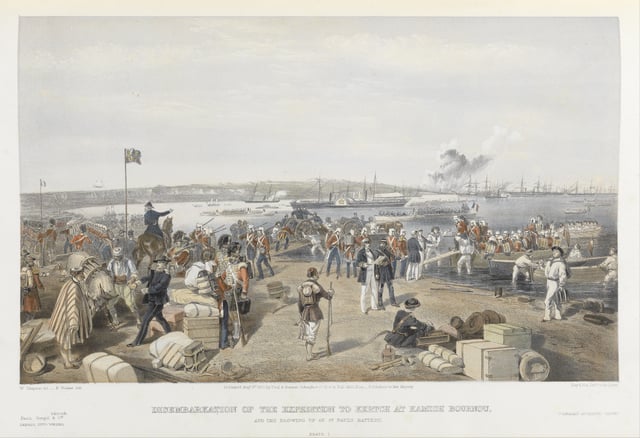
Disembarkation of the expedition to Kerch
In early 1855 the allied Anglo-French commanders decided to send an Anglo-French naval squadron into the Azov Sea to undermine Russian communications and supplies to besieged Sevastopol. On 12 May 1855, Anglo-French warships entered the Kerch Strait and destroyed the coast battery of the Kamishevaya Bay. Once through the Kerch Strait, British and French warships struck at every vestige of Russian power along the coast of the Sea of Azov. Except for Rostov and Azov, no town, depot, building or fortification was immune from attack and Russian naval power ceased to exist almost overnight. This Allied campaign led to a significant reduction in supplies flowing to the besieged Russian troops at Sevastopol.
On 21 May 1855, the gunboats and armed steamers attacked the seaport of Taganrog, the most important hub near Rostov on Don. The vast amounts of food, especially bread, wheat, barley and rye that were amassed in the city after the outbreak of war were prevented from being exported.
The Governor of Taganrog, Yegor Tolstoy, and lieutenant-general Ivan Krasnov refused an allied ultimatum, responding that "Russians never surrender their cities". The Anglo–French squadron bombarded Taganrog for 61⁄2 hours and landed 300 troops near the Old Stairway in the centre of Taganrog, but they were thrown back by Don Cossacks and a volunteer corps.
In July 1855, the allied squadron tried to go past Taganrog to Rostov-on-Don, entering the River Don through the Mius River. On 12 July 1855 HMS Jasper grounded near Taganrog thanks to a fisherman who moved buoys into shallow water. The Cossacks captured the gunboat with all of its guns and blew it up. The third siege attempt was made 19–31 August 1855, but the city was already fortified and the squadron could not approach close enough for landing operations. The allied fleet left the Gulf of Taganrog on 2 September 1855, with minor military operations along the Azov Sea coast continuing until late 1855.
Caucasus theatre
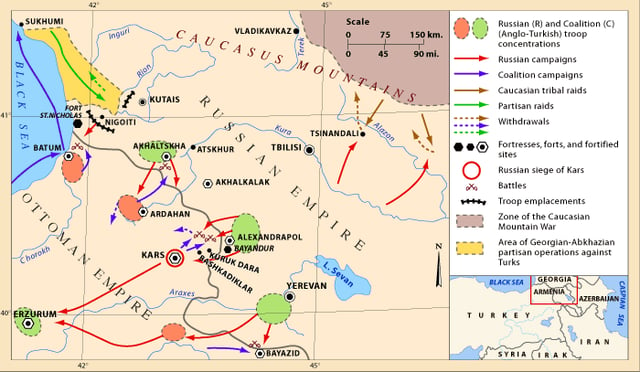
Caucasus front during the Crimean War
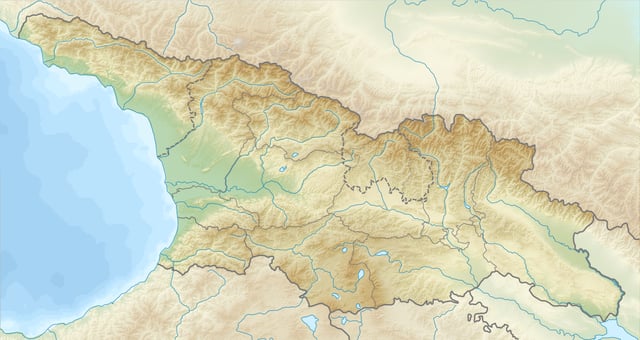
Georgian coast: Ab= Abkhazia; Red=Turkish, Blue=Russian
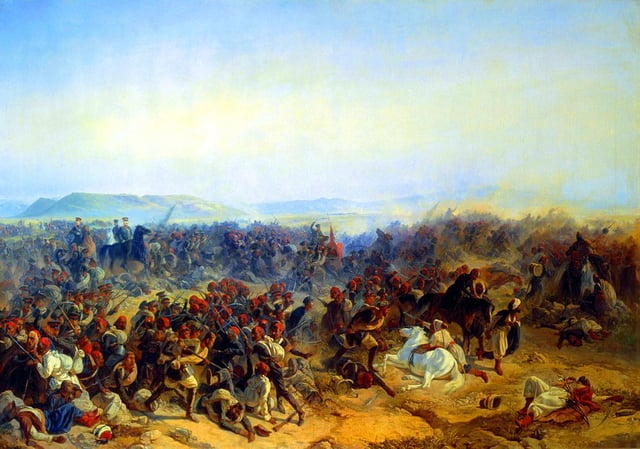
General Bebutashvili defeated the Turks at the Battle of Kurekdere
As in the previous wars the Caucasus front was secondary to what was happening in the west. Perhaps because of better communications western events sometimes influenced the east. The main events were the second capture of Kars and a landing on the Georgian coast. Several commanders on both sides were either incompetent or unlucky and few fought aggressively.[52]
1853: There were four main events. 1. In the north the Turks captured the border fort of Saint Nicholas in a surprise night attack (27/28 October). They then pushed about 20,000 troops across the River Cholok border. Being outnumbered the Russians abandoned Poti and Redut Kale and drew back to Marani. Both sides remained immobile for the next seven months. 2. In the centre the Turks moved north from Ardahan to within cannon-shot of Akhaltsike and awaited reinforcements (13 November). The Russians routed them. The claimed losses were 4,000 Turks and 400 Russians. 3. In the south about 30,000 Turks slowly moved east to the main Russian concentration at Gyumri or Alexandropol (November). They crossed the border and set up artillery south of town. Prince Orbeliani tried to drive them off and found himself trapped. The Turks failed to press their advantage; the remaining Russians rescued Orbeliani and the Turks retired west. Orbeliani lost about 1,000 men out of 5,000. The Russians now decided to advance. The Turks took up a strong position on the Kars road and attacked. They were defeated in the Battle of Başgedikler, losing 6,000 men, half their artillery and all their supply train. The Russians lost 1,300, including Prince Orbeliani. This was Prince Ellico Orbeliani whose wife was later kidnapped by Imam Shamil at Tsinandali. 4. At sea the Turks sent a fleet east which was destroyed by Admiral Nakhimov at Sinope.
1854: The British and French declared war on 3 January. Early in the year the Anglo-French fleet appeared in the Black Sea and the Russians abandoned the Black Sea Defensive Line from Anapa south. N. A. Read, who replaced Vorontsov, fearing an Anglo-French landing in conjunction with Shamil, 3rd Imam of Dagestan and the Persians, recommended withdrawal north of the Caucasus. For this he was replaced by Baryatinsky. When the allies chose a land attack on Sebastopol any plan for a landing in the east was abandoned.
In the north Eristov pushed southwest, fought two battles, forced the Turks back to Batum, retired behind the Cholok River and suspended action for the rest of the year (June). In the far south Wrangel pushed west, fought a battle and occupied Bayazit. In the centre the main forces stood at Kars and Gyumri. Both slowly approached along the Kars-Gyumri road and faced each other, neither side choosing to fight (June–July). On 4 August Russian scouts saw a movement which they thought was the start of a withdrawal, the Russians advanced and the Turks attacked first. They were defeated, losing 8,000 men to the Russian 3,000. 10,000 irregulars deserted to their villages. Both sides withdrew to their former positions. About this time the Persians made a semi-secret agreement to remain neutral in exchange for the cancellation of the indemnity from the previous war.
1855: Kars: In the year up to May 1855 Turkish forces in the east were reduced from 120,000 to 75,000, mostly by disease. The local Armenian population kept Muravyev well-informed about the Turks at Kars and he judged they had about five months of supplies. He therefore decided to control the surrounding area with cavalry and starve them out. He started in May and by June was south and west of the town. A relieving force fell back and there was a possibility of taking Erzerum, but Muravyev chose not to. In late September he learned of the fall of Sevastopol and a Turkish landing at Batum. This led him to reverse policy and try a direct attack. It failed, the Russians losing 8,000 men and the Turks 1,500 (29 September). The blockade continued and Kars surrendered on 8 November.
1855: Georgian coast: Omar Pasha, the Turkish commander at Crimea had long wanted to land in Georgia, but the western powers vetoed it. When they relented in August most of the campaigning season was lost. In September 8,000 Turks landed at Batum, but the main concentration was at Sukhum Kale. This required a 100-mile march south through a country with poor roads. The Russians planned to hold the line of the Ingur River which separates Abkhazia from Georgia proper. Omar crossed the Ingur on 7 November and then wasted a great deal of time, the Russians doing little. By 2 December he had reached the Tskhenis-dzqali, the rainy season had started, his camps were submerged in mud and there was no bread. Learning of the fall of Kars he withdrew to the Ingur. The Russians did nothing and he evacuated to Batum in February of the following year.
Baltic theatre
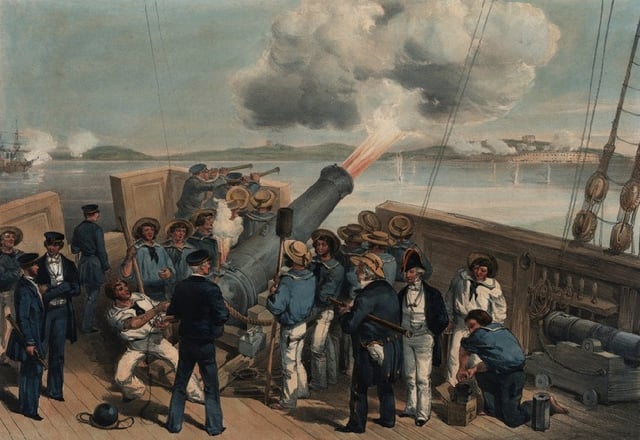
Bombardment of Bomarsund during the Crimean War, after William Simpson
The Baltic was a forgotten theatre of the Crimean War.[53] Popularisation of events elsewhere overshadowed the significance of this theatre, which was close to Saint Petersburg, the Russian capital. In April 1854 an Anglo-French fleet entered the Baltic to attack the Russian naval base of Kronstadt and the Russian fleet stationed there.[54] In August 1854 the combined British and French fleet returned to Kronstadt for another attempt. The outnumbered Russian Baltic Fleet confined its movements to the areas around its fortifications. At the same time, the British and French commanders Sir Charles Napier and Alexandre Ferdinand Parseval-Deschenes—although they led the largest fleet assembled since the Napoleonic Wars—considered the Sveaborg fortress too well-defended to engage. Thus, shelling of the Russian batteries was limited to two attempts in 1854 and 1855, and initially, the attacking fleets limited their actions to blockading Russian trade in the Gulf of Finland.[55] Naval attacks on other ports, such as the ones in the island of Hogland in the Gulf of Finland, proved more successful. Additionally, allies conducted raids on less fortified sections of the Finnish coast.[56] These battles are known in Finland as the Åland War.
Russia depended on imports—both for its domestic economy and for the supply of its military forces: the blockade forced Russia to rely on more expensive overland shipments from Prussia. The blockade seriously undermined the Russian export economy and helped shorten the war.[57]
The burning of tar warehouses and ships led to international criticism, and in London the MP Thomas Gibson demanded in the House of Commons that the First Lord of the Admiralty explain "a system which carried on a great war by plundering and destroying the property of defenceless villagers".[58] In fact, the operations in the Baltic sea were in the nature of binding forces. it was very important to divert Russian forces from the South or, more precisely, not to allow Nicholas to transfer to the Crimea a huge army guarding the Baltic coast and the capital.[59] This goal Anglo-French forces have achieved. The Russian army in Crimea was forced to act without superiority in forces.
In August 1854 a Franco-British naval force captured and destroyed the Russian Bomarsund fortress on Åland Islands. In the August 1855, the Western Allied Baltic Fleet tried to destroy heavily defended Russian dockyards at Sveaborg outside Helsinki. More than 1,000 enemy guns tested the strength of the fortress for two days. Despite the shelling, the sailors of the 120-gun ship Rossiya, led by Captain Viktor Poplonsky, defended the entrance to the harbour. The Allies fired over 20,000 shells but failed to defeat the Russian batteries. The British then built a massive new fleet of more than 350 gunboats and mortar vessels,[60] which was known as the Great Armament, but the war ended before the attack was launched.
Part of the Russian resistance was credited to the deployment of newly invented blockade mines. Perhaps the most influential contributor to the development of naval mining was a Swede resident in Russia, the inventor and civil engineer Immanuel Nobel (the father of Alfred Nobel). Immanuel Nobel helped the Russian war effort by applying his knowledge of industrial explosives, such as nitroglycerin and gunpowder. One account dates modern naval mining from the Crimean War: "Torpedo mines, if I may use this name given by Fulton to self-acting mines underwater, were among the novelties attempted by the Russians in their defences about Cronstadt and Sevastopol", as one American officer put it in 1860.[61]
For the campaign of 1856, Britain and France planned an attack on the main base of the Russian Navy in the Baltic sea - Kronstadt. The attack was to be carried out using armored floating batteries. The use of the latter proved to be highly effective in attacking the sea fortress of Kinburn on the Black sea in 1855. Undoubtedly, this threat contributed on the part of Russia the decision on the conclusion of peace on unfavourable terms.
White Sea theatre
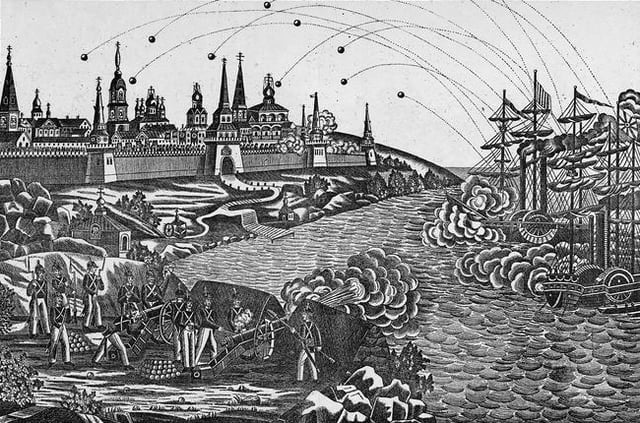
"Bombardment of the Solovetsky Monastery in the White Sea by the Royal Navy", a lubok (popular print) from 1868
In late 1854, a squadron of three British warships led by HMS Miranda left the Baltic for the White Sea, where they shelled Kola (which was destroyed) and the Solovki. Their attempt to storm Arkhangelsk proved unsuccessful.
Pacific theatre
Minor naval skirmishes also occurred in the Far East, where at Petropavlovsk on the Kamchatka Peninsula a British and French Allied squadron including HMS Pique under Rear Admiral David Price and a French force under Counter-Admiral Auguste Febvrier Despointes besieged a smaller Russian force under Rear Admiral Yevfimiy Putyatin. In September 1854, an Allied landing force was beaten back with heavy casualties, and the Allies withdrew. The victory at Petropavlovsk was for Russia in the words of the future military Minister Milyutin "a ray of light among the dark clouds". The Russians escaped under the cover of snow in early 1855 after Allied reinforcements arrived in the region.
The Anglo-French forces in the Far East also made several small landings on Sakhalin and Urup, one of the Kuril Islands.[62]
Piedmontese involvement
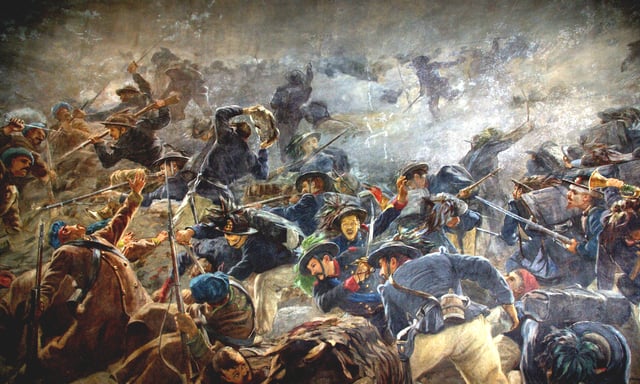
The Bersaglieri halt the Russian attack during the Battle of the Chernaya.
Camillo di Cavour, under orders of Victor Emmanuel II of Piedmont-Sardinia, sent an expeditionary corps of 15,000 soldiers, commanded by General Alfonso La Marmora, to side with French and British forces during the war.[63] [] This was an attempt at gaining the favour of the French, especially when the issue of uniting Italy would become an important matter. The deployment of Italian troops to the Crimea, and the gallantry shown by them in the Battle of the Chernaya (16 August 1855) and in the siege of Sevastopol, allowed the Kingdom of Sardinia to be among the participants at the peace conference at the end of the war, where it could address the issue of the Risorgimento to other European powers.
Greece
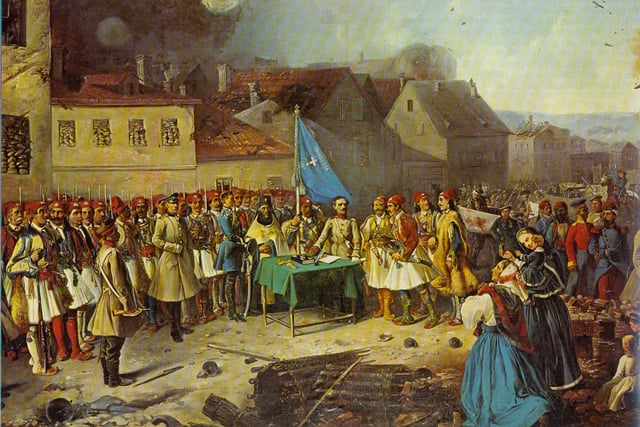
A Greek battalion fought for Russia at Sevastopol
Greece played a peripheral role in the war. When Russia attacked the Ottoman Empire in 1853, King Otto of Greece saw an opportunity to expand north and south into Ottoman areas that had large Greek Christian majorities. Greece did not coordinate its plans with Russia, did not declare war, and received no outside military or financial support. Greece, an Orthodox nation, had considerable support in Russia, but the Russian government decided it was too dangerous to help Greece expand its holdings.[10] [] When the Russians invaded the Principalities, the Ottoman forces were tied down so Greece invaded Thessaly and Epirus. To block further Greek moves, the British and French occupied the main Greek port at Piraeus from April 1854 to February 1857,[64] and effectively neutralized the Greek army. Greeks, gambling on a Russian victory, incited the large-scale Epirus Revolt of 1854 as well as uprisings in Crete. The insurrections were failures that were easily crushed by the Ottoman army. Greece was not invited to the peace conference and made no gains out of the war.[10] [] [65] The frustrated Greek leadership blamed the King for failing to take advantage of the situation; his popularity plunged and he was forced to abdicate in 1862.
Kiev Cossack revolt
A peasant revolt that began in the Vasylkiv county of Kiev Governorate (province) in February 1855 spread across the whole Kiev and Chernigov governorates, with peasants refusing to participate in corvee labor and other orders of the local authorities, in some cases attacking priest who were accused of hiding a decree about the liberation of the peasants.[66]
End of the war
British position
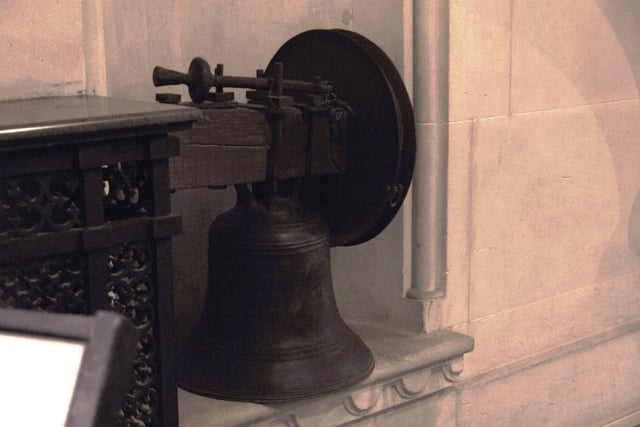
One of three 17th-century church bells in Arundel Castle, England. These were taken from Sevastopol as trophies at the end of the Crimean War.
Dissatisfaction with the conduct of the war was growing with the public in Britain and in other countries, aggravated by reports of fiascos, especially the devastating losses of the heroic Charge of the Light Brigade at the Battle of Balaclava. On Sunday, 21 January 1855, a "snowball riot" occurred in Trafalgar Square near St Martin-in-the-Fields in which 1,500 people gathered to protest against the war by pelting buses, cabs and pedestrians with snow balls.[67] When the police intervened, the snowballs were directed at the officers. The riot was finally put down by troops and police acting with truncheons.[67] In Parliament, Tories demanded an accounting of all soldiers, cavalry and sailors sent to the Crimea and accurate figures as to the number of casualties that had been sustained by all British armed forces in the Crimea; they were especially concerned with the Battle of Balaclava. When Parliament passed a bill to investigate by the vote of 305 to 148, Aberdeen said he had lost a vote of no confidence and resigned as prime minister on 30 January 1855.[68] The veteran former Foreign Secretary Lord Palmerston became prime minister.[69] Palmerston took a hard line; he wanted to expand the war, foment unrest inside the Russian Empire, and permanently reduce the Russian threat to Europe. Sweden and Prussia were willing to join Britain and France, and Russia was isolated.[10] []
Peace negotiations
The negotiations began in Paris in February 1856 and were surprisingly easy. France under the leadership of Napoleon III had no special interests in the Black sea, so did not support the British and Austrian tough proposals.[70]
Peace negotiations at the Congress of Paris resulted in the signing of the Treaty of Paris on 30 March 1856.[71] In compliance with article III, Russia restored to the Ottoman Empire the city and citadel of Kars in common with "all other parts of the Ottoman territory of which the Russian troop were in possession". Russia returned the Budjak, in Bessarabia, back to Moldavia.[72][73] By article IV Britain, France, Sardinia and Turkey restored to Russia "the towns and ports of Sevastopol, Balaklava, Kamish, Eupatoria, Kerch, Jenikale, Kinburn as well as all other territories occupied by the allied troops". In conformity with article XI and XIII, the Tsar and the Sultan agreed not to establish any naval or military arsenal on the Black Sea coast. The Black Sea clauses weakened Russia, and it no longer posed a naval threat to the Ottomans. The principalities of Moldavia and Wallachia were nominally returned to the Ottoman Empire; in fact, the Austrian Empire was forced to abandon their annexation and end the occupation[74] in practice they became independent. The Great Powers pledged to respect the independence and territorial integrity of the Ottoman Empire.[10] []
Aftermath in Russia
Some members of the Russian intelligentsia saw defeat as a pressure to modernise their society. Grand Duke Constantine (son of the Tsar) remarked that,[75]
Long-term effects of the Treaty
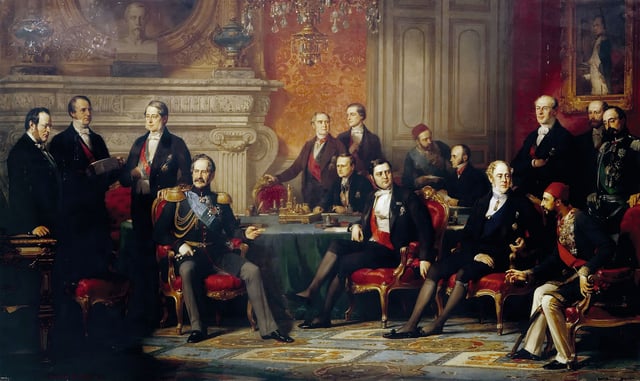
Treaty of Paris (1856)
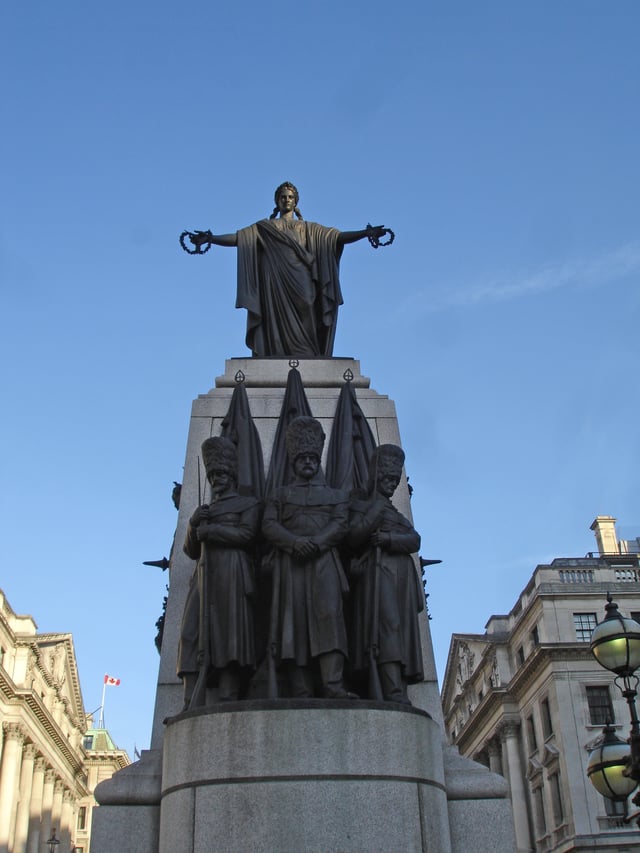
Crimean War Memorial at Waterloo Place, St James's, London
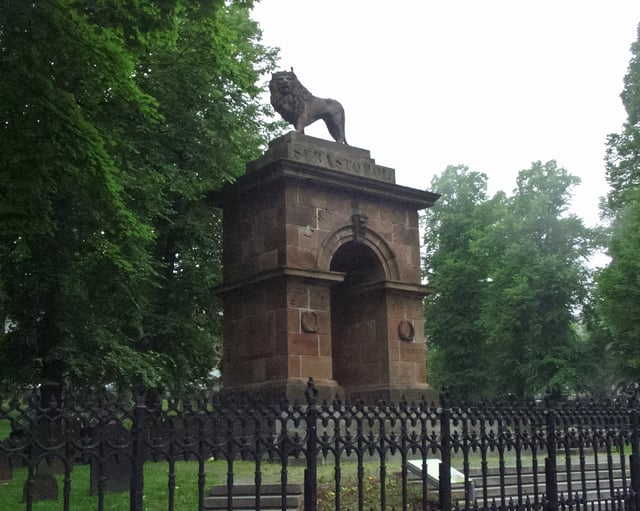
Sebastopol Monument, Halifax, Nova Scotia – the only Crimean War Monument in North America
The Treaty of Paris stood until 1871, when Prussia defeated France in the Franco-Prussian War of 1870–71. While Prussia and several other German states united to form a powerful German Empire in January 1871, the French deposed Emperor Napoleon III and proclaimed the Third French Republic (September 1870). During his reign, Napoleon, eager for the support of the United Kingdom, had opposed Russia over the Eastern Question. Russian interference in the Ottoman Empire did not in any significant manner threaten the interests of France, and France abandoned its opposition to Russia after the establishment of the republic. Encouraged by the new attitude of French diplomacy and supported by the German Chancellor Otto von Bismarck, Russia in October 1870 renounced the Black Sea clauses of the treaty agreed to in 1856. As the United Kingdom with Austria[76] could not enforce the clauses, Russia once again established a fleet in the Black Sea.
Historian Norman Rich argues that the war was not an accident, but was sought out by the determination of the British and French not to allow Russia an honourable retreat. Both insisted on a military victory to enhance their prestige in European affairs when a nonviolent peaceful political solution was available. The war then wrecked the Concert of Europe, which had long kept the peace.[77]
Turkish historian Candan Badem wrote, "Victory in this war did not bring any significant material gain, not even a war indemnity. On the other hand, the Ottoman treasury was nearly bankrupted due to war expenses".[78] Badem adds that the Ottomans achieved no significant territorial gains, lost the right to a navy in the Black Sea and lost its status as a great power. Further, the war gave impetus to the union of the Danubian principalities and ultimately to their independence.
The treaty punished the defeated Russia, but in the long run, Austria lost the most from the war despite having barely taken part in it.[10] [] Having abandoned its alliance with Russia, Austria remained diplomatically isolated following the war,[10] [] which contributed to its disastrous defeats in the 1859 Franco-Austrian War that resulted in the cession of Lombardy to the Kingdom of Sardinia and later in the loss of the Habsburg rule of Tuscany and Modena, which meant the end of Austrian influence in peninsular Italy. Furthermore, Russia did not do anything to assist its former ally, Austria, in the 1866 Austro-Prussian War,[10] [] when Austria lost Venetia and, more importantly, its influence in most German-speaking lands. The status of Austria as a great power, with the unifications of Germany and Italy, now became very precarious. It had to compromise with Hungary; the two countries shared the Danubian Empire and Austria slowly became little more than a German satellite. With France now hostile to Germany and gravitating towards Russia, and with Russia competing with the newly renamed Austro-Hungarian Empire for an increased role in the Balkans at the expense of the Ottoman Empire, the foundations were in place for building the diplomatic alliances that would shape the First World War of 1914.
The Treaty's guarantees to preserve Ottoman territories were broken 21 years later when Russia, exploiting nationalist unrest in the Balkans and seeking to regain lost prestige, once again declared war on the Ottoman Empire on 24 April 1877. In this later Russo-Turkish War the states of Romania, Serbia, and Montenegro gained international recognition of their independence and Bulgaria achieved its autonomy from direct Ottoman rule.
The Crimean War marked the re-ascendancy of France to the position of pre-eminent power on the Continent,[10] [] the continued decline of the Ottoman Empire and the beginning of a decline for Tsarist Russia. As Fuller notes, "Russia had been beaten on the Crimean peninsula, and the military feared that it would inevitably be beaten again unless steps were taken to surmount its military weakness."[79] The war also marked the demise of the Concert of Europe, the balance-of-power system that had dominated Europe since the Congress of Vienna in 1815 and had included France, Russia, Austria and the United Kingdom.
According to historian Shepard Clough, the war
was not the result of a calculated plan, nor even of hasty last-minute decisions made under stress. It was the consequence of more than two years of fatal blundering in slow-motion by inept statesmen who had months to reflect upon the actions they took. It arose from Napoleon's search for prestige; Nicholas's quest for control over the Straits; his naive miscalculation of the probable reactions of the European powers; the failure of those powers to make their positions clear; and the pressure of public opinion in Britain and Constantinople at crucial moments.[80]
The view of 'diplomatic drift' as the cause of the war was first popularised by A. W. Kinglake, who portrayed the British as victims of newspaper sensationalism and duplicitous French and Ottoman diplomacy.
More recently, historians Andrew Lambert and Winfried Baumgart have argued that Britain was following a geopolitical strategy in aiming to destroy the fledgling Russian Navy, which might challenge the Royal Navy for control of the seas, and that the war was also a joint European response to a century of Russian expansion not just southwards but also into Western Europe.[30][73]
In 1870, Prussia persuaded Russia to remain neutral in the Franco-Prussian war.[81] Bismarck, having declared it impossible to keep 100 million Russians in a humiliated position without sovereign rights to their Black Sea coastline,[82] supported Russia against the Treaty of Paris, and in return, it achieved freedom of action against France in 1870-1871 and inflicted a crushing defeat on it.
Documentation
Documentation of the war was provided by William Howard Russell (writing for The Times newspaper) and the photographs of Roger Fenton.[10] [] News from war correspondents reached all nations involved in the war and kept the public citizenry of those nations better informed of the day-to-day events of the war than had been the case in any other war to that date. The British public was very well informed regarding the day-to-day realities of the war in the Crimea. After the French extended the telegraph to the coast of the Black Sea in late 1854, the news reached London in two days. When the British laid an underwater cable to the Crimean peninsula in April 1855, news reached London in a few hours. The daily news reports energised public opinion, which brought down the Aberdeen government and carried Lord Palmerston into office as prime minister.[10] []
Criticisms and reform
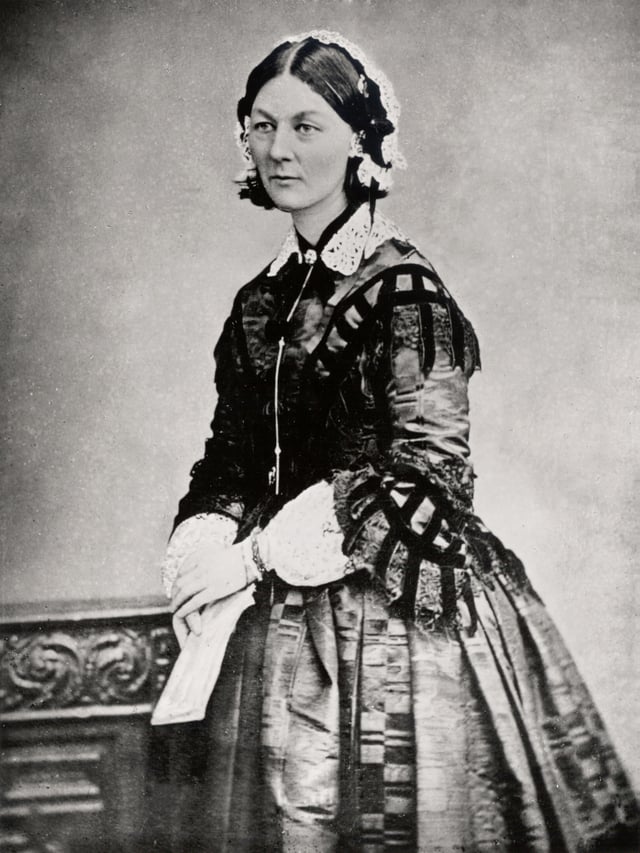
During the Crimean War, Florence Nightingale and her team of nurses cleaned up the military hospitals and set up the first training school for nurses in the United Kingdom.[83]
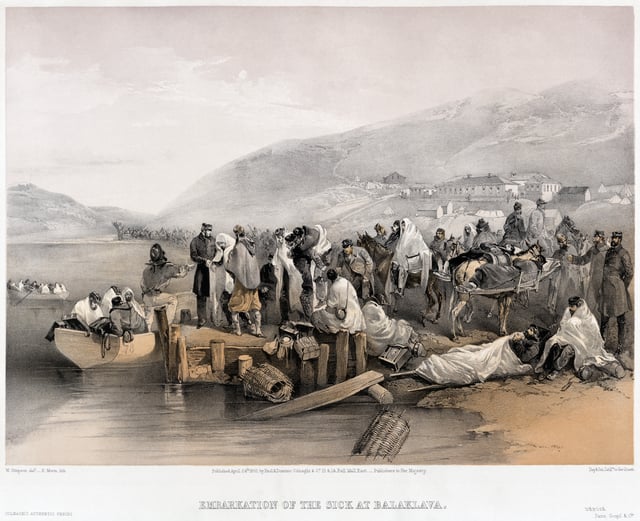
A tinted lithograph by William Simpson illustrating conditions of the sick and injured in Balaklava
Historian R.B. McCallum points out the war was enthusiastically supported by the British populace as it was happening, but the mood changed very dramatically afterwards. Pacifists and critics were unpopular but:
in the end they won. Cobden and Bright were true to their principles of foreign policy, which laid down the absolute minimum of intervention in European affairs and a deep moral reprobation of war ... When the first enthusiasm was passed, when the dead were mourned, the sufferings revealed, and the cost counted, when in 1870 Russia was able calmly to secure the revocation of the Treaty, which disarmed her in the Black Sea, the view became general of the war was stupid and unnecessary, and effected nothing ... The Crimean war remained as a classic example ... of how governments may plunge into war, how strong ambassadors may mislead weak prime ministers, how the public may be worked up into a facile fury, and how the achievements of the war may crumble to nothing. The Bright-Cobden criticism of the war was remembered and to a large extent accepted [especially by the Liberal Party]. Isolation from European entanglements seemed more than ever desirable.[84][85]
As the memory of the "Charge of the Light Brigade" demonstrates, the war became an iconic symbol of logistical, medical and tactical failures and mismanagement. Public opinion in Britain was outraged at the logistical and command failures of the war; the newspapers demanded drastic reforms, and parliamentary investigations demonstrated the multiple failures of the Army.[86] The reform campaign was not well organised, and the traditional aristocratic leadership of the Army pulled itself together, and blocked all serious reforms. No one was punished. The outbreak of the Sepoy Mutiny in 1857 shifted attention to the heroic defence of British interest by the army, and further talk of reform went nowhere.[87] The demand for professionalisation was achieved by Florence Nightingale, who gained worldwide attention for pioneering and publicising modern nursing while treating the wounded.[10] []
The Crimean War also saw the first tactical use of railways and other modern inventions, such as the electric telegraph, with the first "live" war reporting to The Times by William Howard Russell. Some credit Russell with prompting the resignation of the sitting British government through his reporting of the lacklustre condition of British forces deployed in Crimea. Additionally, the telegraph reduced the independence of British overseas possessions from their commanders in London due to such rapid communications. Newspaper readership informed public opinion in the United Kingdom and France as never before.[88] It was the first European war to be photographed. The Russians installed telegraph links to Moscow and St Petersburg during the war, and expanded their rail network south of Moscow after the peace treaty.
The war also employed modern military tactics, such as trenches and blind artillery fire. The use of the Minié ball for shot, coupled with the rifling of barrels, greatly increased the range and the damage caused by the allied weapons.
The British Army system of sale of commissions came under great scrutiny during the war, especially in connection with the Battle of Balaclava, which saw the ill-fated Charge of the Light Brigade. This scrutiny later led to the abolition of the sale of commissions.
During the Crimean war, the first use of steam armored ships in the military history took place. Three Dévastation-class floating batteries were successfully used against the sea fortress of Kinburn in the autumn of 1855. The direct initiator of this military innovation was the French Emperor Napoleon III. The military threat of the use of this new weapon in the campaign of 1856 contributed to Russia's acceptance of the unfavourable conditions of the Paris treaty of 1856.
Scientist Faraday received a proposal from the British government to develop chemical weapons for use in the siege of Sevastopol. Faraday categorically refused and publicly condemned the proposal and his position contributed to the rejection of the development and use of these weapons during the Crimean war.
The Crimean War was a contributing factor in the Russian abolition of serfdom in 1861: Tsar Alexander II (Nicholas I's son and successor) saw the military defeat of the Russian serf-army by free troops from Britain and France as proof of the need for emancipation.[89] The Crimean War also led to the realisation by the Russian government of its technological inferiority, in military practices as well as weapons.[90]
Meanwhile, Russian military medicine saw dramatic progress: N. I. Pirogov, known as the father of Russian field surgery, developed the use of anaesthetics, plaster casts, enhanced amputation methods, and five-stage triage in Crimea, among other things.
The war also led to the establishment of the Victoria Cross in 1856 (backdated to 1854), the British Army's first universal award for valour. 111 medals were awarded.
The British issued the Crimea Medal with 5 clasps, and the Baltic Medal, as well as Valour medals, including the newly created Distinguished Conduct Medal, the Turkish the Turkish Crimea Medal, the French did not issue a campaign medal, issuing Médaille militaire and Legion of Honour for bravery, Sardinia also issued a medal. Russia issued a Defence of Sevastopol, and a Crimean War medal.
Chronology of major battles of the war
Battle of Sinop, 30 November 1853
Siege of Silistra, 5 April – 25 June 1854
First Battle of Bomarsund, 21 June 1854
Second Battle of Bomarsund, 15 August 1854
Siege of Petropavlovsk, 30–31 August 1854, on the Pacific coast
Battle of Alma, 20 September 1854
Siege of Sevastopol, 25 September 1854 to 8 September 1855
Battle of Balaclava, 25 October 1854 (see also Charge of the Light Brigade and the Thin Red Line)
Battle of Inkerman, 5 November 1854
Battle of Eupatoria, 17 February 1855
Battle of the Chernaya (aka "Battle of Traktir Bridge"), 16 August 1855
Battle of Kinburn (1855), 17 October 1855
Sea of Azoff naval campaign, May to November 1855
Siege of Kars, June to 28 November 1855
Prominent military commanders
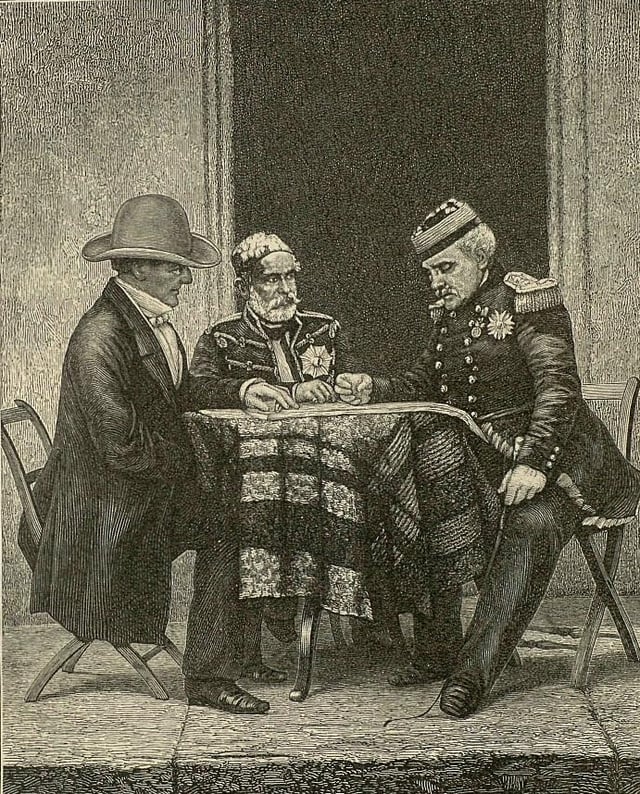
FitzRoy Somerset, Omar Pasha and Marshal Pélissier
Russian commanders Prince Mikhail Dmitriyevich Gorchakov Count and Namestnik Ivan Feodorovich Paskevich Admiral Pavel Stepanovich Nakhimov vice admiral Vladimir Kornilov General Eduard Ivanovich Totleben Prince Aleksandr Sergeyevich Menshikov
French commanders Marshal Jacques Leroy de Saint Arnaud Marshal François Certain Canrobert Marshal Aimable Pélissier Marshal Pierre Bosquet Marshal Patrice de MacMahon
Ottoman commanders General Abdülkerim Nadir Pasha General Omar Pasha General Iskender Pasha General Ismail Pasha[91] General Władysław Stanisław Zamoyski
British commanders James Brudenell, 7th Earl of Cardigan FitzRoy Somerset, 1st Baron Raglan Sir Edmund Lyons (later 1st Baron Lyons) George Charles Bingham, 3rd Earl of Lucan Admiral Charles John Napier Colin Campbell, 1st Baron Clyde
Kingdom of Sardinia commanders General Alfonso Ferrero La Marmora General Giovanni Durando General Alessandro La Marmora
Last veterans
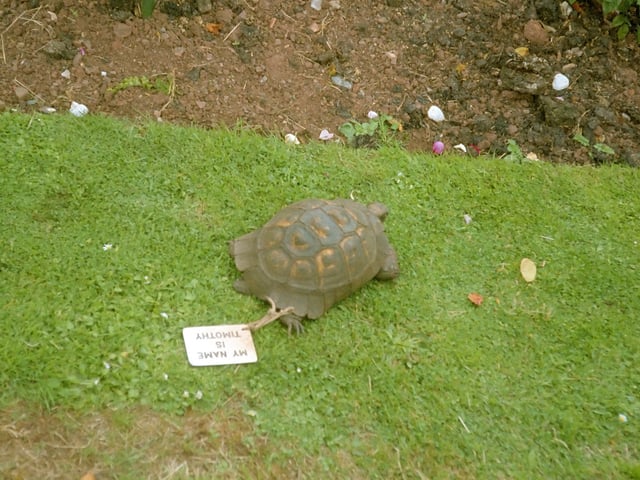
A British naval mascot, Timothy (1839–2004) was the last "veteran" of the Crimean War
Edwin Bezar (1838–1936). Last British soldier. Also last British Army veteran (and possibly last combatant) of the New Zealand Wars.
Yves Prigent (1833–1938). French sailor.[92]
Charles Nathan (1834–1934). Last French soldier, also saw action in Italy, Syria, Mexico and the Franco-Prussian War.[92]
Edwin Hughes (1830–1927). Last survivor of the Charge of the Light Brigade.[93]
Luigi Palma di Cesnola (1832–1904). An Italian soldier who served with the British Army in the Crimean War as the aide-de-camp to General Enrico Fardella. Also served in the American Civil War, on the Union Side.[94][95]
Timothy the Tortoise (1839–2004). The naval mascot of HMS Queen.[96]
In popular culture
"The Charge of the Light Brigade" by Alfred, Lord Tennyson depicted a brave but disastrous cavalry charge during the Battle of Balaclava.
Leo Tolstoy wrote a few short sketches on the Siege of Sevastopol, collected in The Sebastopol Sketches. The stories detail the lives of the Russian soldiers and citizens in Sevastopol during the siege. Because of this work, Tolstoy has been called the world's first war correspondent (Although Tolstoy was not a correspondent, he was the commander of the artillery battery Bastion number 4, the most dangerous place of defense).
In James Joyce's Finnegans Wake II.3, the Crimean War, especially the Battle of Balaclava, figures prominently. One of the focuses of that dense chapter is a radio program in which Butt & Taff retell an idiosyncratic anecdote from that battle, in which an Irishman named Buckley shot a Russian general.
Jack Archer: A Tale of the Crimea by G. A. Henty, 1883, a historical novel, details the adventures of two British midshipmen in the Crimean War.
The events of the Crimean War are depicted in the 1973 novel Flashman at the Charge in which the eponymous antihero participates in the battles of Sevastopol and Balaclava.
Franz Roubaud. Panorama Siege of Sevastopol (1854–1855)
Charge of the Light Brigade – 1936 film starring Errol Flynn
In the Little Rascals episode Two Too Young, from 1936, Alfalfa recites the Lord Tennyson poem.
The Charge of the Light Brigade – 1968 film starring John Gielgud and Trevor Howard
To the most famous works of the writer Sergeev-Tsensky S. N. refers historical novel-epic "Sevastopol Strada" (English: Sevastopol campaign) (1937-1939), dedicated to the first defense of Sevastopol in 1854-1855.
The Eyre Affair by Jasper Fforde is an alternative history novel where the Crimean War has been raging for over 130 years and is still ongoing, albeit at a stalemate at the time of the novel.
A different alternative history treatment of the Crimean War is S. M. Stirling's story "The Charge of Lee's Brigade".[97]
"The Trooper", song by Iron Maiden included in their 1983 album Piece of Mind, inspired by Lord Tennyson's poem, describes the charge from the point of view of a British soldier.
The music video for the Kasabian song "Empire" is set in the Crimean War and depicts the band's members as soldiers of the 11th Hussars Regiment.
The Great Train Robbery by Michael Crichton was set on the English homefront during the Crimean War. The plot revolved around stealing gold intended for the British troops from a moving steam train. It was later made into The First Great Train Robbery (known as The Great Train Robbery in the U.S.), starring Sean Connery. The novel was based on the Great Gold Robbery of 1855.
The events of the Crimean war are covered in the Russian film of 1911 Defence of Sevastopol.
The events of the Crimean war are covered in the 1946 Soviet film "Admiral Nakhimov".
Boris Akunin, under his Anatoly Brusnikin pen name, published the historical novel Bellona (Беллона) (2012), centring on the Crimean War from the Russian side.
Jasper Kent's novel The Third Section takes Crimean War as a background event for its horror theme. Other novelists taking the war as background include Garry Kilworth, A L Berridge and Paul Fraser Collard.
See also
British Crimea Medal and Turkish Crimea Medal
Crimean War Research Society
Grand Crimean Central Railway
Foreign policy of the Russian Empire
International relations (1814–1919)
List of Crimean War Victoria Cross recipients
List of British recipients of the Légion d'Honneur for the Crimean War
Peace Concluded (painting)
Order of Nakhimov